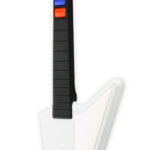“My guitar is not a thing,” Joan Jett famously declared. “It is an extension of myself. It is who I am.” This powerful sentiment encapsulates the profound relationship musicians have with their guitars, especially in rock music. The guitar, in its many forms, has become the quintessential instrument of rock, capable of expressing a vast spectrum of emotions, from raw primal energy to delicate, nuanced beauty. While anyone can strum a few chords, mastering the guitar to a level of true greatness is a lifelong journey. This exploration of guitar mastery is precisely what makes contemplating the Greatest Rock Guitar Players so endlessly fascinating.
Inspired by Rolling Stone’s notable lists of guitarists, we delve deeper into the realm of the greatest rock guitar players, aiming to not just list names, but to explore what truly defines greatness in rock guitar. While Rolling Stone’s lists, compiled by panels of musicians and editors, offer valuable perspectives, this expanded exploration seeks to provide a more comprehensive and SEO-optimized view for English-speaking audiences eager to discover and appreciate the titans of rock guitar.
Rock guitarists often transcend their role as instrumentalists, becoming iconic figures as recognizable as the lead singers of their bands. Mythic figures like Jimmy Page, Eddie Van Halen, and Brian May are foundational to the rock guitar pantheon, but the story of rock guitar is far broader and more diverse. We aim to showcase the incredible evolution and scope of guitar playing. From pioneers born in the late 19th century to contemporary innovators, the reach of rock guitar is vast. Our exploration encompasses not just rock, but the myriad genres the guitar has conquered: jazz, blues, country, folk, punk, metal, reggae, funk, and beyond. We celebrate both the peerless virtuosos, those with almost superhuman technical abilities, and the raw primitivists, who channel pure feeling and energy. We acknowledge the stadium-filling stars and the unsung heroes whose influence resonates deeply within the music itself.
This list values innovation over imitation, soulfulness over sterile perfection, and the courage to take risks over predictable refinement. Crucially, we celebrate guitarists who have channeled their unique gifts into crafting unforgettable songs and albums that have shaped music history, not just those who can play impressive solos in a vacuum. As modern blues visionary Gary Clark Jr. aptly put it, the essence is in venturing out, exploring new territories, while staying connected to the heart of the music. Join us as we celebrate these extraordinary musicians, the greatest rock guitar players who have defined and continue to redefine the sonic landscape of rock and roll.
Andy Summers
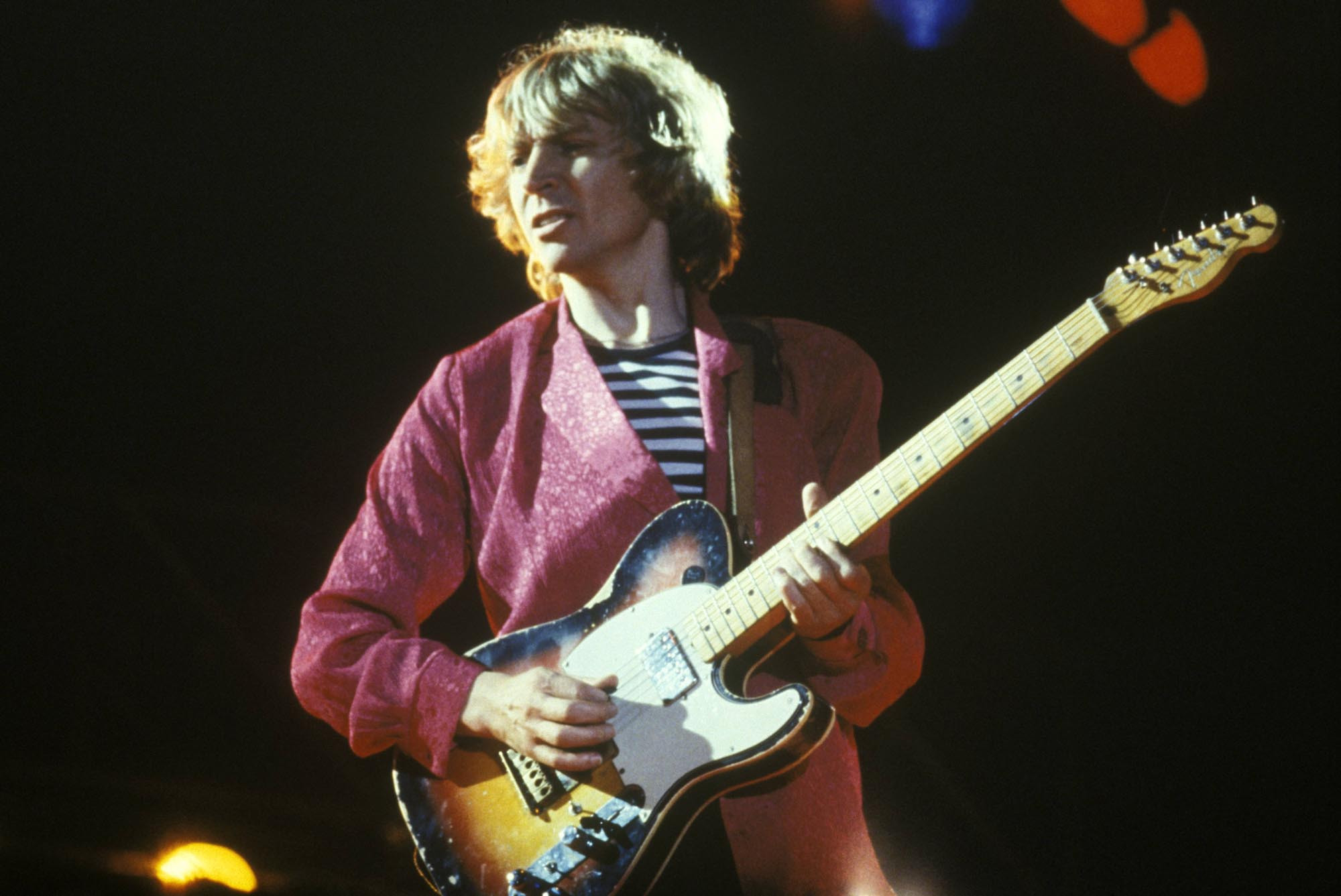 Andy Summers of The Police performing live on stage, playing a Fender Telecaster guitar, showcasing his innovative guitar work in a power trio setting.
Andy Summers of The Police performing live on stage, playing a Fender Telecaster guitar, showcasing his innovative guitar work in a power trio setting.
Andy Summers was the essential ingredient in The Police’s groundbreaking sound. Moving swiftly beyond the confines of punk, Summers masterfully blended jazz chord voicings and reggae-infused rhythms into a potent rock and roll concoction. His signature style was defined by its deliberate sparseness. He constructed sonic landscapes with clipped, percussive twitches and dub-like washes of sound, brilliantly creating space for the dynamic interplay of Sting’s vocals and bass and Stewart Copeland’s intricate drumming. This minimalist approach, however, was incredibly sophisticated and impactful. As Rush’s Alex Lifeson observed, “His tone and style were just absolutely perfect — he left space around everything.” Summers’ versatility is undeniable; he effortlessly navigates from delicate acoustic passages to complex jazz harmonies and experimental hybrid styles, making him a truly unique and influential guitarist in the landscape of rock.
Key Tracks: “Message in a Bottle,” “Every Breath You Take”
Brittany Howard
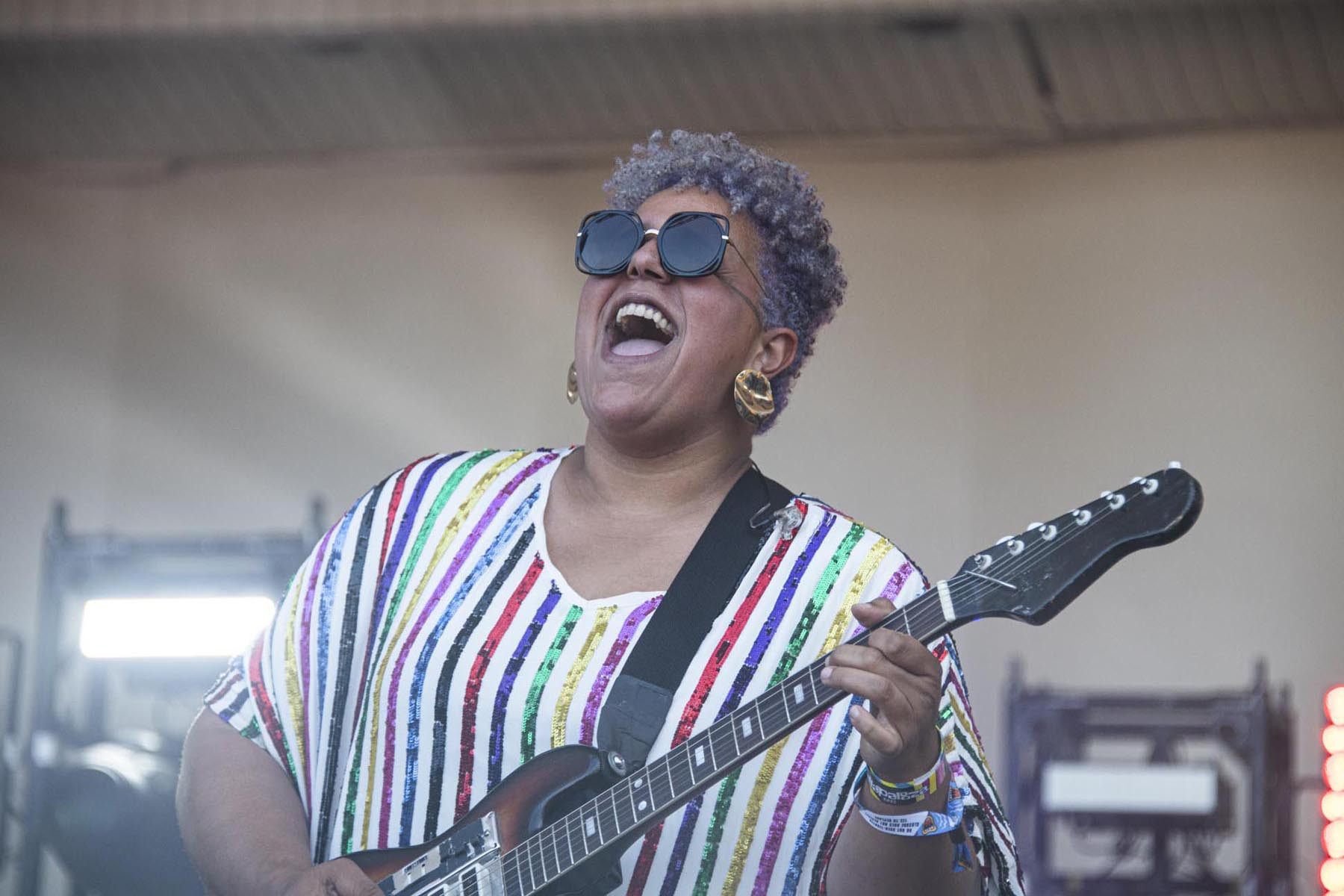 Brittany Howard, known for her soulful vocals and earthy guitar playing, pictured for Rolling Stone, highlighting her versatile musicianship.
Brittany Howard, known for her soulful vocals and earthy guitar playing, pictured for Rolling Stone, highlighting her versatile musicianship.
From her beginnings with the garage-roots band Alabama Shakes, Brittany Howard’s guitar playing has been characterized by its raw, organic feel, perfectly complementing her powerhouse vocals and deeply soulful songwriting. Her rhythmic sensibility is remarkably elastic. Listen to how her sharp, jagged guitar lines interact with Alabama Shakes’ lead guitarist Heath Fogg on their 2015 track “Don’t Wanna Fight”—it’s a masterclass in rhythmic interplay. Howard further demonstrated her range by diving into straight-ahead rock and roll with her side project Thunderbitch. Her critically acclaimed 2019 solo album, Jaime, served as a powerful showcase for her expansive musicianship. From the funky, James Brown-esque rhythms of “History Repeats” to the thick, molten fuzz that coats “Presence,” Howard’s guitar work is as diverse and compelling as her vocal performances, establishing her as a force to be reckoned with in modern rock music.
Key Tracks: “History Repeats,” “Presence”
Robby Krieger
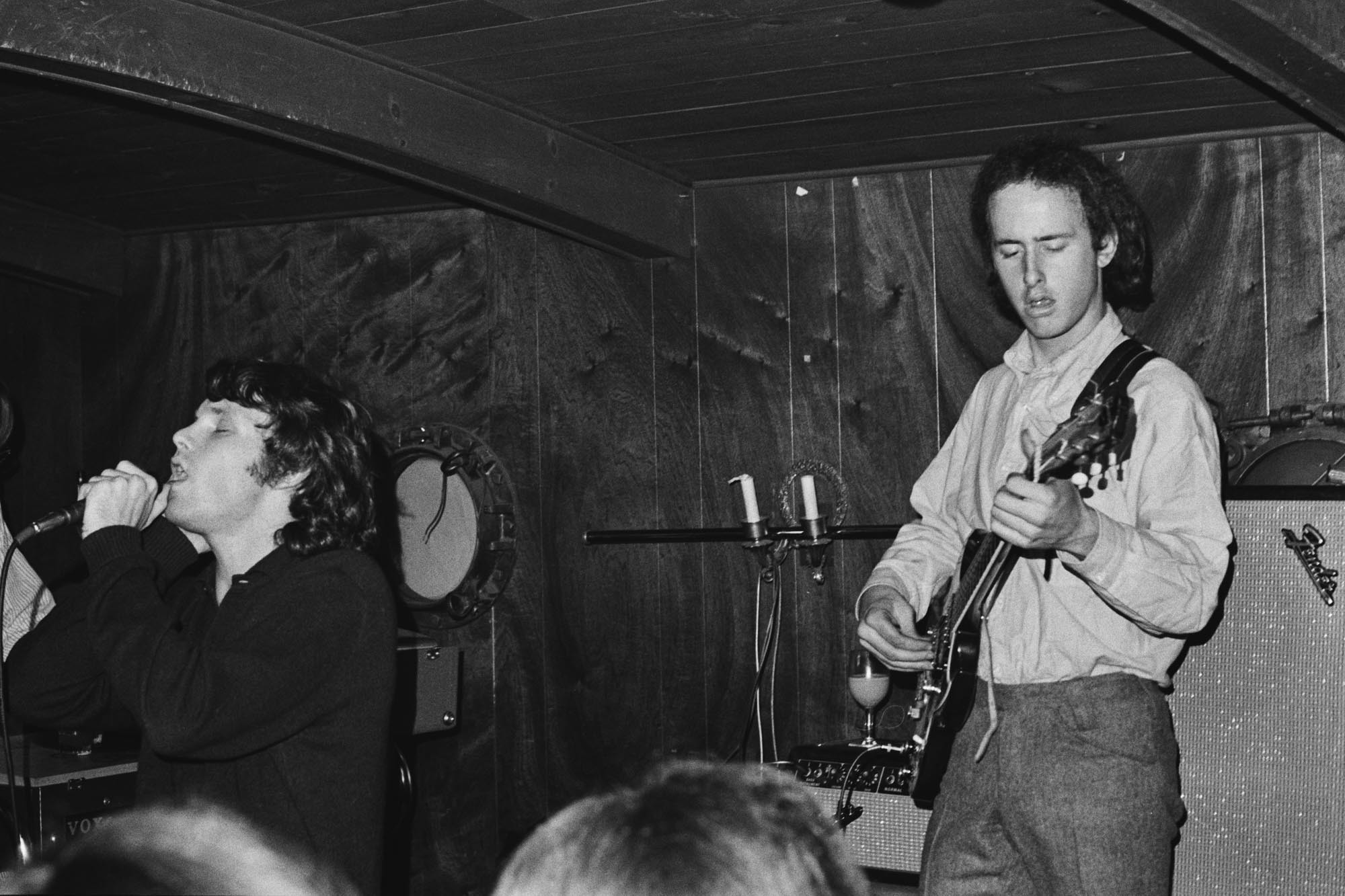 Robby Krieger of The Doors performing live in 1966, showcasing his flamenco and jazz-influenced guitar style that expanded rock boundaries.
Robby Krieger of The Doors performing live in 1966, showcasing his flamenco and jazz-influenced guitar style that expanded rock boundaries.
Robby Krieger, with his background in flamenco and jazz, fearlessly pushed the boundaries of rock guitar at a time when many guitarists remained firmly rooted in blues traditions. As the guitarist for The Doors, Krieger possessed the improvisational brilliance to follow Jim Morrison’s unpredictable and often psychedelic musical explorations. He was also a key songwriter for the band, penning some of their biggest hits, including the iconic “Light My Fire.” In the unconventional keyboard-drums-guitar lineup of The Doors, Krieger’s role was even more critical. “Not having a bass player … made me play more bass notes to fill out the bottom,” he explained, highlighting his adaptive and innovative approach. “Not having a rhythm player also made me play differently, to fill out the sound. I always felt like three players simultaneously.” This unique context allowed Krieger to develop a distinctive and influential guitar style that was integral to The Doors’ groundbreaking sound.
Key Tracks: “Riders on the Storm,” “Roadhouse Blues”
Ricky Wilson
 Ricky Wilson of The B-52s performing in 1978, highlighting his unique and inventive guitar style within the New Wave era.
Ricky Wilson of The B-52s performing in 1978, highlighting his unique and inventive guitar style within the New Wave era.
In the vibrant live performances of The B-52s, Ricky Wilson often appeared to be a quiet presence, a contrast to the exuberant front man Fred Schneider and the visually captivating Kate Pierson and Cindy Wilson. However, Wilson’s guitar work was anything but understated. His distinctive blend of down-home chicken scratch funk, angular post-punk sensibilities, rockabilly twang, and surf rock reverb, evident in classics like “52 Girls,” “Strobe Light,” and “Private Idaho,” established him as one of the most original guitarists of the New Wave era. Wilson frequently employed only four or five strings on his signature blue Mosrite guitar and experimented with unconventional tunings to achieve his strange, minimalist sound. “I just tune the strings till I hear something I like,” he famously said, reflecting his intuitive and experimental approach. His untimely death in 1985 marked a significant loss for the indie-rock scene, which mourned a truly unassuming and radical innovator.
Key Tracks: “52 Girls,” “Mesopotamia”
Paul Simon
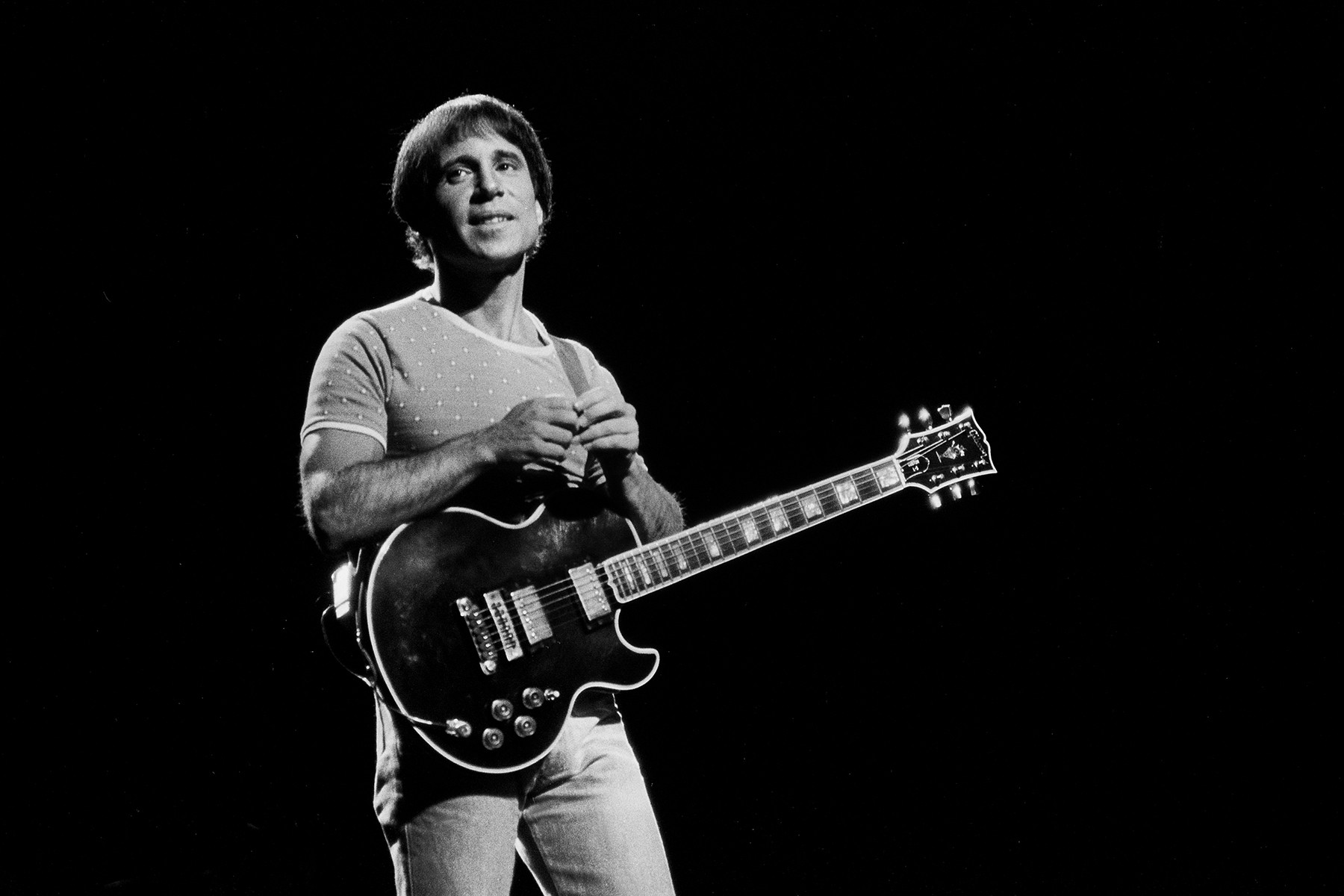 Paul Simon playing guitar on stage in 1980, showcasing his ability to speak through his guitar as vividly as through his lyrics.
Paul Simon playing guitar on stage in 1980, showcasing his ability to speak through his guitar as vividly as through his lyrics.
Paul Simon, celebrated as a master wordsmith, also communicates with remarkable eloquence through his guitar. Influenced by early doo-wop and rock & roll, Simon immersed himself in the folk revival of the mid-1960s, even traveling to England to study the acoustic guitar mastery of Bert Jansch. His musical journey has been marked by continuous absorption of new influences, as exemplified in “Dazzling Blue” from his album So Beautiful or So What. He noted, “All that folk fingerpicking is what I did with Simon and Garfunkel, but [here] it’s on top of this rhythm with Indian musicians playing in 12/8.” Even into his 80s, Simon remains remarkably nimble and inventive, a fact underscored by his 2023 album Seven Psalms. His guitar playing is an integral part of his songwriting and storytelling, proving that his musical genius extends far beyond just his lyrical prowess.
Key Tracks: “Dazzling Blue,” “Kathy’s Song”
Leslie West
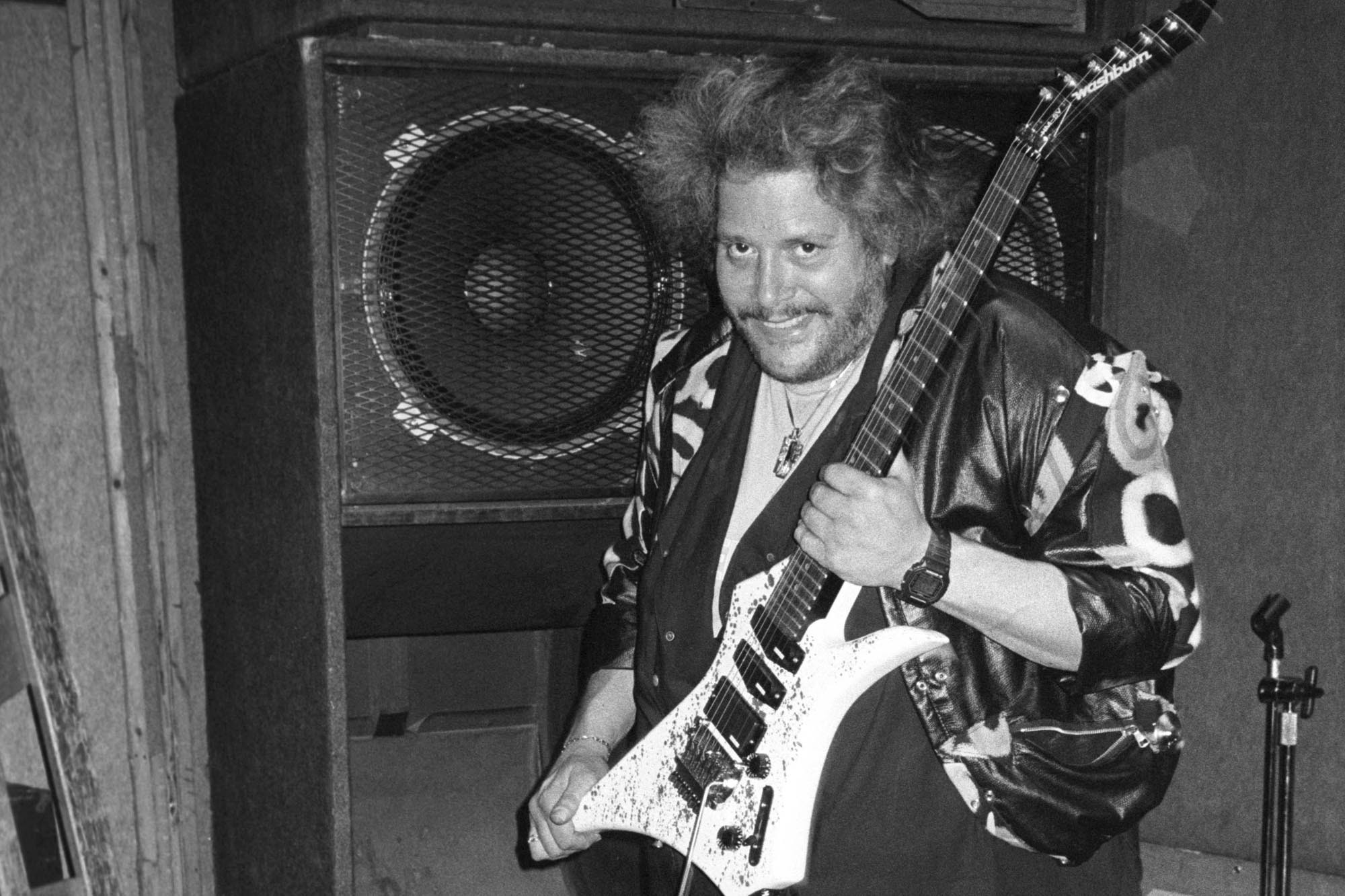 Leslie West of Mountain performing live, known for his heavy, blues-infused guitar riffs and powerful stage presence.
Leslie West of Mountain performing live, known for his heavy, blues-infused guitar riffs and powerful stage presence.
Leslie West (born Leslie Weinstein) first gained attention in the mid-1960s garage rock scene with the Vagrants’ powerful rendition of Otis Redding’s “Respect.” By 1969, West became the driving force behind the Cream-esque quartet Mountain, injecting a heavy dose of blues-rock intensity. On iconic tracks like the 1970 hit “Mississippi Queen,” West delivered raw, blues-infused guitar lines with deceptive ease and a distinct R&B flair, all through a wall of heavily distorted amplifier sound. “The riffs were incredible,” remarked Dave Davies of The Kinks. “He could play flashy, intricate phrases. But he wasn’t a look-at-me guy. He played with feel.” West’s powerful riffs and soulful approach cemented his place as a foundational figure in heavy rock guitar playing.
Key Tracks: “Mississippi Queen,” “Nantucket Sleighride (To Owen Coffin)”
Edilio Paredes
 Edilio Paredes, the maestro of bachata guitar, whose innovative playing defined the sound of the genre, pictured in a promotional shot.
Edilio Paredes, the maestro of bachata guitar, whose innovative playing defined the sound of the genre, pictured in a promotional shot.
Bachata, once a relatively obscure genre outside the Dominican Republic, has recently gained global recognition, thanks to pop stars like Rosalía and The Weeknd incorporating its distinctive sound into mainstream hits. Central to bachata’s sonic identity are the uniquely poignant and spiraling guitar lines that underscore the genre’s themes of lost love and longing. The architect of this signature guitar sound is Edilio Paredes. A self-taught prodigy, Paredes was instrumental in the evolution of bachata from bolero campesino to the contemporary, internationally recognized Afro-Caribbean genre it is today. His extensive discography as a highly sought-after session musician from the 1960s to the 1980s speaks volumes about his influence. Paredes’ legacy was further solidified with his appearance on the celebrated 2011 album The Bachata Legends, affirming his status as el maestro of bachata guitar.
Key Tracks: “No Me Olvides,” “Bendita Nena”
Aaron Dessner and Bryce Dessner
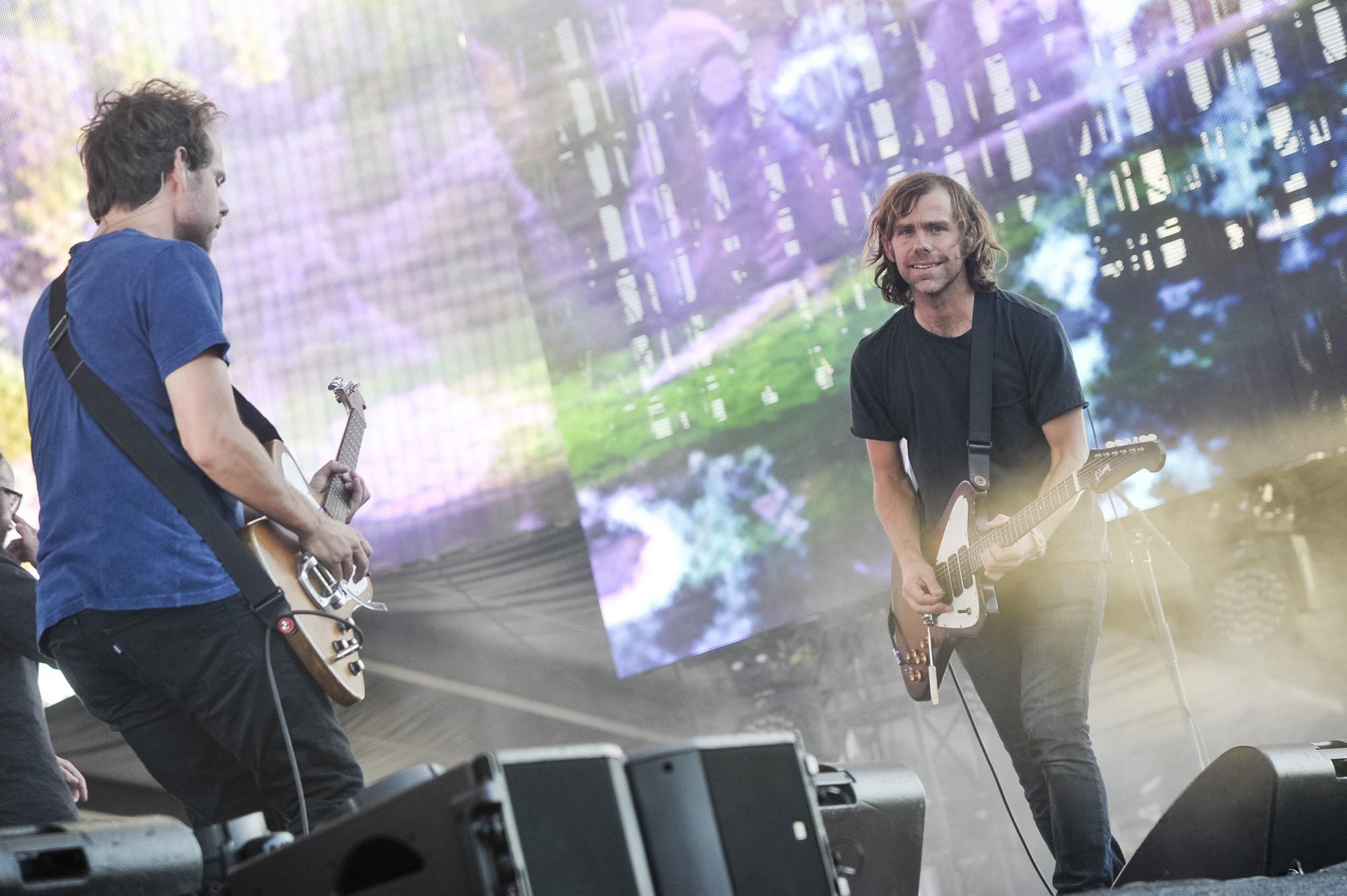 Aaron and Bryce Dessner of The National performing live, a twin-guitar duo known for their virtuosic and collaborative approach to rock music.
Aaron and Bryce Dessner of The National performing live, a twin-guitar duo known for their virtuosic and collaborative approach to rock music.
The National’s story is unique in rock, centered around the exceptional twin-guitar partnership of twin brothers Aaron and Bryce Dessner. Bryce Dessner’s collaborations extend far beyond rock, encompassing work with contemporary classical music luminaries like Steve Reich, Ryuichi Sakamoto, Jonny Greenwood, and the Kronos Quartet. Aaron Dessner has become Taylor Swift’s key guitar collaborator on Folklore and Evermore, adding a Jerry Garcia-esque twang to tracks like “Cowboy Like Me” and unleashing more raw energy on “August” in The Long Pond Studio Sessions. Together, the Dessner brothers create a dynamic guitar interplay, seamlessly transitioning from electric intensity in tracks like “Terrible Love” to intimate folk beauty in “I Need My Girl.” Their versatility and collaborative spirit are further highlighted by their curatorial role in the acclaimed 2016 Grateful Dead tribute album Day of the Dead, where they jammed with Bob Weir on “I Know You Rider.” Their combined talents make them a truly distinctive and influential guitar duo in modern rock.
Key Tracks: “Mr. November,” “Bloodbuzz Ohio,” “The System Only Dreams in Total Darkness”
Lindsey Jordan
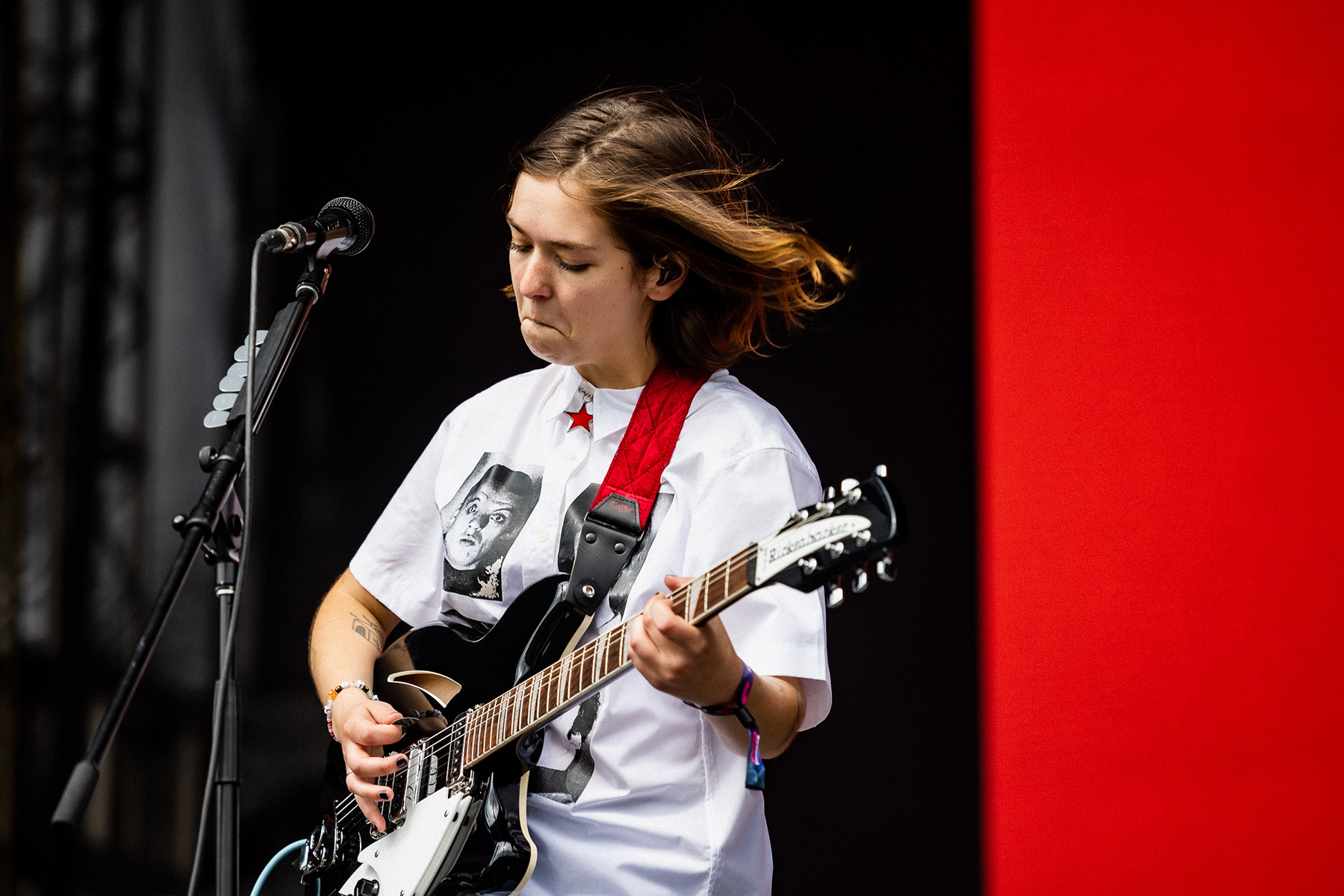 Lindsey Jordan of Snail Mail performing at Governors Ball 2023, a Gen Z guitar hero known for blending indie-rock traditions with virtuosity.
Lindsey Jordan of Snail Mail performing at Governors Ball 2023, a Gen Z guitar hero known for blending indie-rock traditions with virtuosity.
Lindsey Jordan, a leading figure in Gen Z guitar rock, honed her skills under the tutelage of Mary Timony, a highly inventive guitarist known for her work in Helium and Wild Flag. When Jordan debuted as Snail Mail at just 18 years old with the 2018 album Lush, she seemed to have already internalized the entire indie-rock guitar canon. She is both a casual virtuoso and a serious shredder, effortlessly moving between strummed, tension-building passages and explosive, cathartic solos. Her style ranges from coolly understated Liz Phair-esque lo-fi sounds to expansive Sonic Youth-inspired sonic textures. “I like to play really balls out,” she stated in a 2018 interview with Rolling Stone, emphasizing her commitment to raw and authentic performance. “That’s what it means to be onstage with integrity.” Jordan represents a new generation of guitarists who are both technically skilled and deeply connected to the emotional core of rock music.
Key Tracks: “Heat Wave,” “Pristine”
Keith Urban
 Keith Urban performing live in 2001, known for his effortless and song-elevating guitar style in country music, with rock influences.
Keith Urban performing live in 2001, known for his effortless and song-elevating guitar style in country music, with rock influences.
Keith Urban may not be the most overtly flashy or traditionally country guitarist in Nashville, but he stands out for his incredibly fluid and natural style. His guitar riffs, rhythms, and solos seem to emerge as spontaneously as thought itself, yet they consistently elevate the songs they inhabit. There’s nothing forced or gratuitous in his playing; every note feels purposeful and perfectly placed. Studio recordings and live performances equally showcase Urban’s guitar prowess. However, it’s on stage where his guitar heroics truly come to the forefront, rivaling some of the greatest names in rock guitar history. His broad appeal and guitar skills have led to collaborations with artists ranging from the Rolling Stones to Nile Rodgers. “I love that people want to hear the guitar,” Urban shared with Rolling Stone in 2015, “but I just think about the song … whatever the song seems to want.” This song-centric approach is the hallmark of his guitar greatness.
Key Tracks: “Highway Don’t Care,” “Blue Ain’t Your Color”
Erin Smith
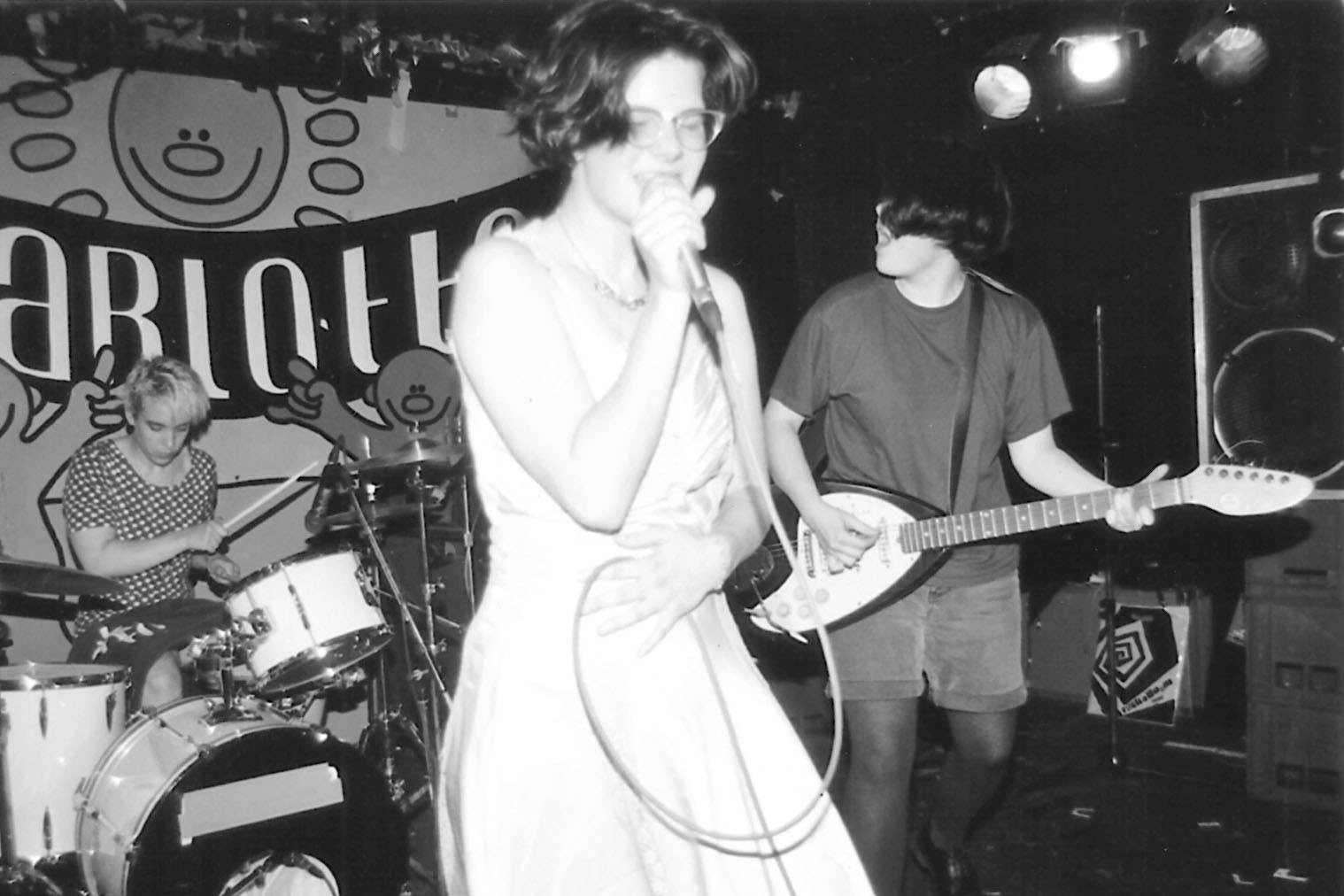 Erin Smith of Bratmobile, pictured in a live performance, a pioneer of riot grrrl guitar sound combining surf-rock basslines with garage-rock chords.
Erin Smith of Bratmobile, pictured in a live performance, a pioneer of riot grrrl guitar sound combining surf-rock basslines with garage-rock chords.
Erin Smith, guitarist for the riot grrrl pioneers Bratmobile, found her initial inspiration in Beat Happening, a deliberately lo-fi cuddle-core band with a female drummer. “That was in ’87, and not only did I see women could play music, but I could see that just you could do it yourself,” she recounted to the Museum of Pop Culture. “I could never be [Duran Duran’s] Andy Taylor. And I realized that was OK.” The distinctive guitar style she developed with singer Allison Wolfe and drummer Molly Neuman fused melodic surf-rock bass lines with raw, slashing garage-rock chords. This sonic combination was crucial to Bratmobile’s groundbreaking 1993 debut album, Pottymouth, which remains a seminal and exciting punk record of the 1990s. Smith’s DIY ethos and unique guitar approach were pivotal in shaping the riot grrrl sound and inspiring countless female musicians.
Key Tracks: “Love Thing,” “P.R.D.C.T.”
Duane Eddy
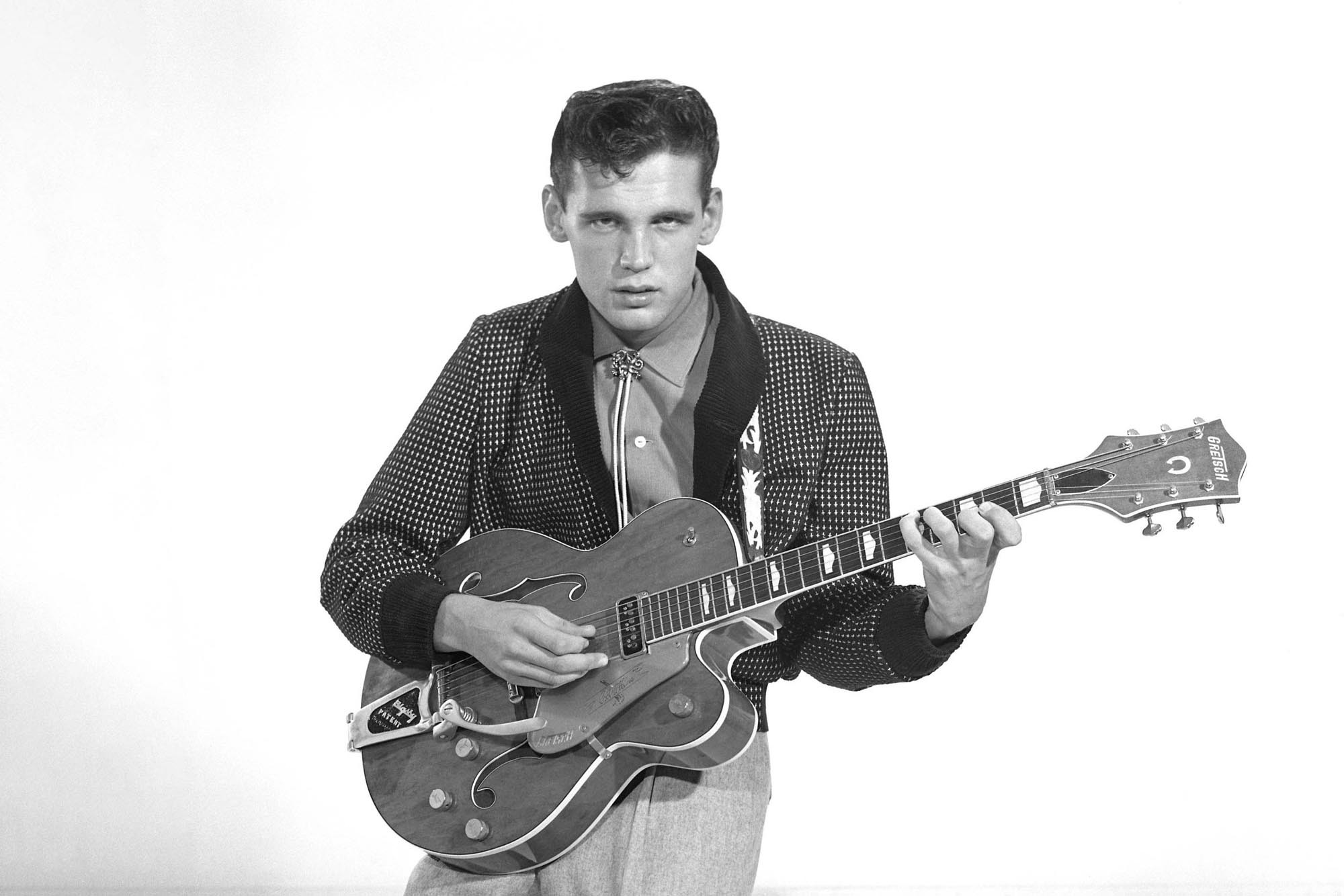 Duane Eddy posing in 1958, a guitar pioneer who solidified the guitar's role as rock and roll's lead instrument with his twangy and tremolo-rich sound.
Duane Eddy posing in 1958, a guitar pioneer who solidified the guitar's role as rock and roll's lead instrument with his twangy and tremolo-rich sound.
If there was any lingering doubt in the late 1950s about whether the guitar, and not the saxophone, was the defining lead instrument of rock & roll, Duane Eddy decisively settled the debate. His 1958 hit single “Rebel Rouser,” characterized by its country twang and shimmering tremolo, became a sonic landmark. “Chet Atkins used vibrato in a selective way — Duane Eddy used it to thrash the music,” noted Dave Davies of The Kinks, highlighting Eddy’s more aggressive and pervasive use of tremolo. Eddy’s hits, including “Forty Miles of Bad Road” and “Peter Gunn,” had a profound and immediate impact, foreshadowing the surf music genre and influencing guitarists like Jeff Beck and George Harrison. His signature “twangy guitar” sound was instantly recognizable and hugely influential, cementing his place as a true guitar pioneer.
Key Tracks: “Rebel Rouser,” “Peter Gunn”
Doug Gillard
 Doug Gillard of Guided by Voices performing live, known for being the band's beating heart and a perfect complement to Robert Pollard's genius.
Doug Gillard of Guided by Voices performing live, known for being the band's beating heart and a perfect complement to Robert Pollard's genius.
Within the Ohio indie-rock institution Guided By Voices, Robert Pollard is often seen as the eccentric genius, but Doug Gillard is undeniably the band’s musical heart. He serves as the ideal complement to Pollard’s unconventional wordplay and experimental sonic ideas, transforming them into cohesive rock and roll songs, often at an astonishingly prolific pace of two or even three albums per year. “I know his usual shapes and drones — or can pretty much decipher what they are if it’s a new shape — and replicate them on the rhythm parts on the records for the most part,” Gillard explained in an interview. “But also, I have some freedom to transform them.” His ability to interpret and enhance Pollard’s vision while injecting his own guitar personality makes him an indispensable and highly valued guitarist in the indie rock world.
Key Tracks: “I Am a Tree,” “Mr. Child”
Jennifer Batten
Jennifer Batten rose to prominence as the visually striking and sonically powerful “guitar hurricane” on Michael Jackson’s record-breaking world tours. This high-profile gig demanded incredible versatility, requiring her to seamlessly navigate funk, soul, metal, and even Eddie Van Halen’s iconic “Beat It” solo night after night. Her debut solo album, 1992’s Above Below and Beyond, demonstrated her wide-ranging abilities, featuring electric guitar renditions of Rimsky-Korsakov’s “Flight of the Bumble Bee,” Jackson’s “Wanna Be Startin’ Somethin’,” and John Coltrane’s “Giant Steps,” all infused with her signature whammy bar techniques and finger-tapping wizardry. Batten further solidified her reputation as a top-tier guitarist by touring and recording with Jeff Beck, holding her own alongside the legendary guitarist on some of his most experimental and groundbreaking albums around the turn of the millennium. Her technical prowess and fearless approach make her a true guitar virtuoso.
Key Tracks: “Flight of the Bumblebee,” “Giant Steps (Rock Version)”
Greg Sage
 Greg Sage of The Wipers performing live in 1986, a pioneer of Pacific Northwestern indie-rock known for his complex songs and miasmically distorted guitar sound.
Greg Sage of The Wipers performing live in 1986, a pioneer of Pacific Northwestern indie-rock known for his complex songs and miasmically distorted guitar sound.
Greg Sage formed The Wipers in Portland, Oregon, in 1977, pioneering a sound that transcended punk orthodoxies even before they fully solidified. His band was characterized by complex, sprawling song structures and a uniquely jagged, miasmically distorted guitar sound. At a time when many punk bands prioritized raw simplicity, Wipers songs like “When It’s Over” and “Romeo” felt like immersive and pummeling sonic landscapes. As a result, The Wipers became a galvanizing force in the Pacific Northwestern indie-rock scene. Kurt Cobain famously declared, “We learned everything from the Wipers. They were playing a mix of punk and hard rock when nobody cared.” Sage’s innovative approach to guitar and songwriting profoundly influenced the development of indie rock, particularly in the Pacific Northwest.
Key Tracks: “When It’s Over,” “Up Front”
Laura Marling
British singer-songwriter and multi-instrumentalist Laura Marling embodies a more understated form of virtuosity. She masterfully employs complex tunings and chord voicings in her music that often sound deceptively simple and natural. “I Was an Eagle,” from her 2013 album One I Was an Eagle, exemplifies this, creating a dreamy and atmospheric soundscape through her use of DADDAD tuning. The influence of Joni Mitchell is palpable in her work, evident in her unusual phrasing and subtle atonal flourishes. During the COVID-19 lockdown, Marling generously shared her guitar expertise with fans, offering concise and informative tutorials on Instagram, further demonstrating her deep knowledge and passion for the instrument. Her nuanced approach to guitar playing is integral to the evocative and introspective nature of her music.
Key Tracks: “I Was an Eagle,” “Wild Fire,” “Ghosts”
John McGeoch
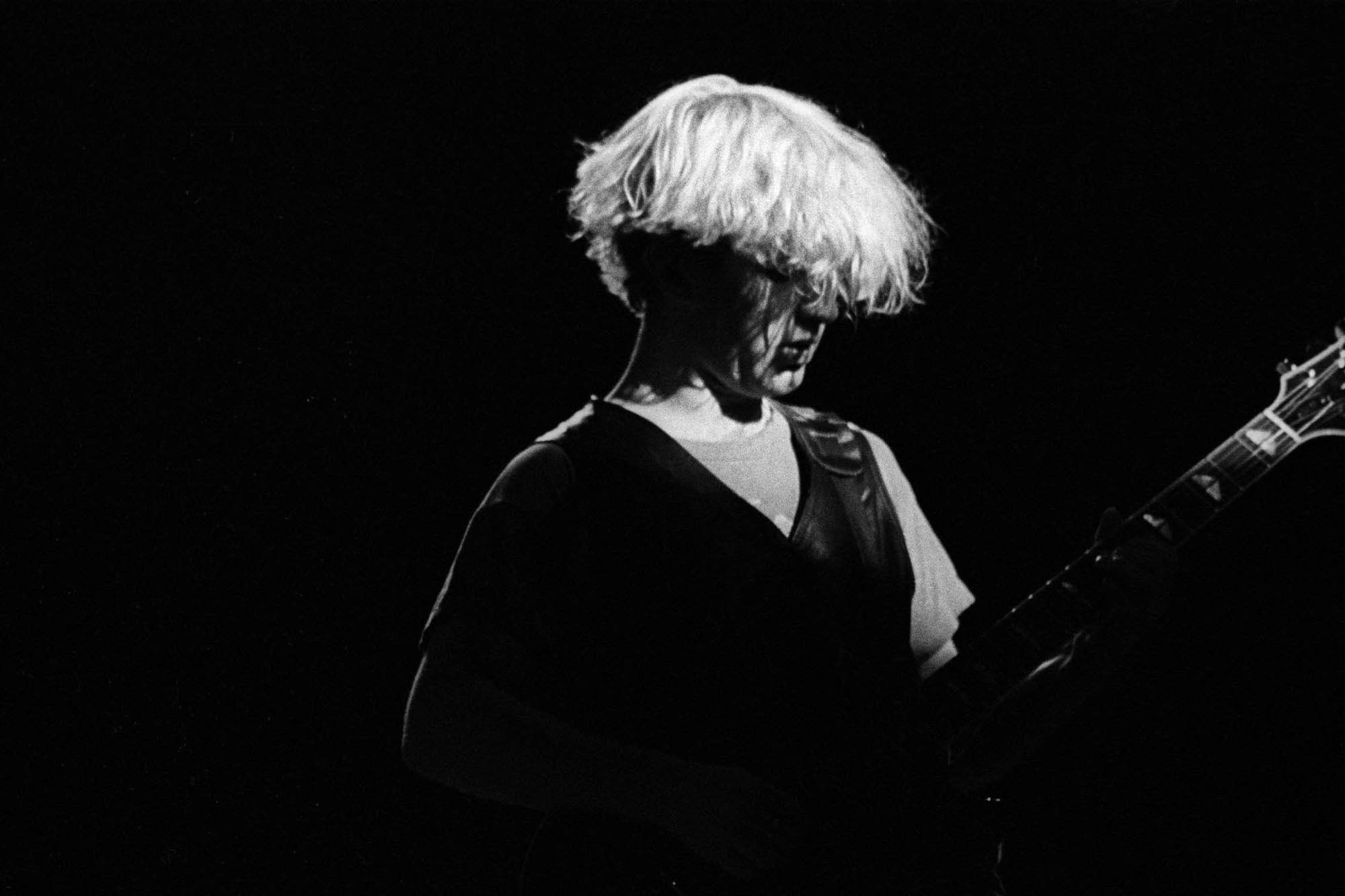 John McGeoch of Siouxsie and the Banshees performing live in 1980, known for his expansive and atmospheric goth-guitar style, influential in post-punk.
John McGeoch of Siouxsie and the Banshees performing live in 1980, known for his expansive and atmospheric goth-guitar style, influential in post-punk.
John McGeoch, hailing from Manchester, made a powerful entrance with the soaring guitar attack on Magazine’s 1978 debut single, “Shot by Both Sides,” a defining anthem of UK punk rock. He quickly evolved to create his own expansive and architecturally structured guitar style, evident in Magazine’s subsequent work, as well as his contributions to Public Image Ltd and Siouxsie and the Banshees. McGeoch earned high praise from guitarists like Johnny Marr and Radiohead’s Ed O’Brien, among others, for his innovative approach. His signature blend of slashing rhythm guitar, swirling arpeggios, and atmospheric flange effects reached its zenith on Siouxsie and the Banshees’ 1981 album, Juju. This album is considered a landmark in goth-guitar, introducing a moody and atmospheric new language to UK rock, where texture and ambiance took precedence over overt angst.
Key Tracks: “Philadelphia,” “Spellbound”
H.E.R.
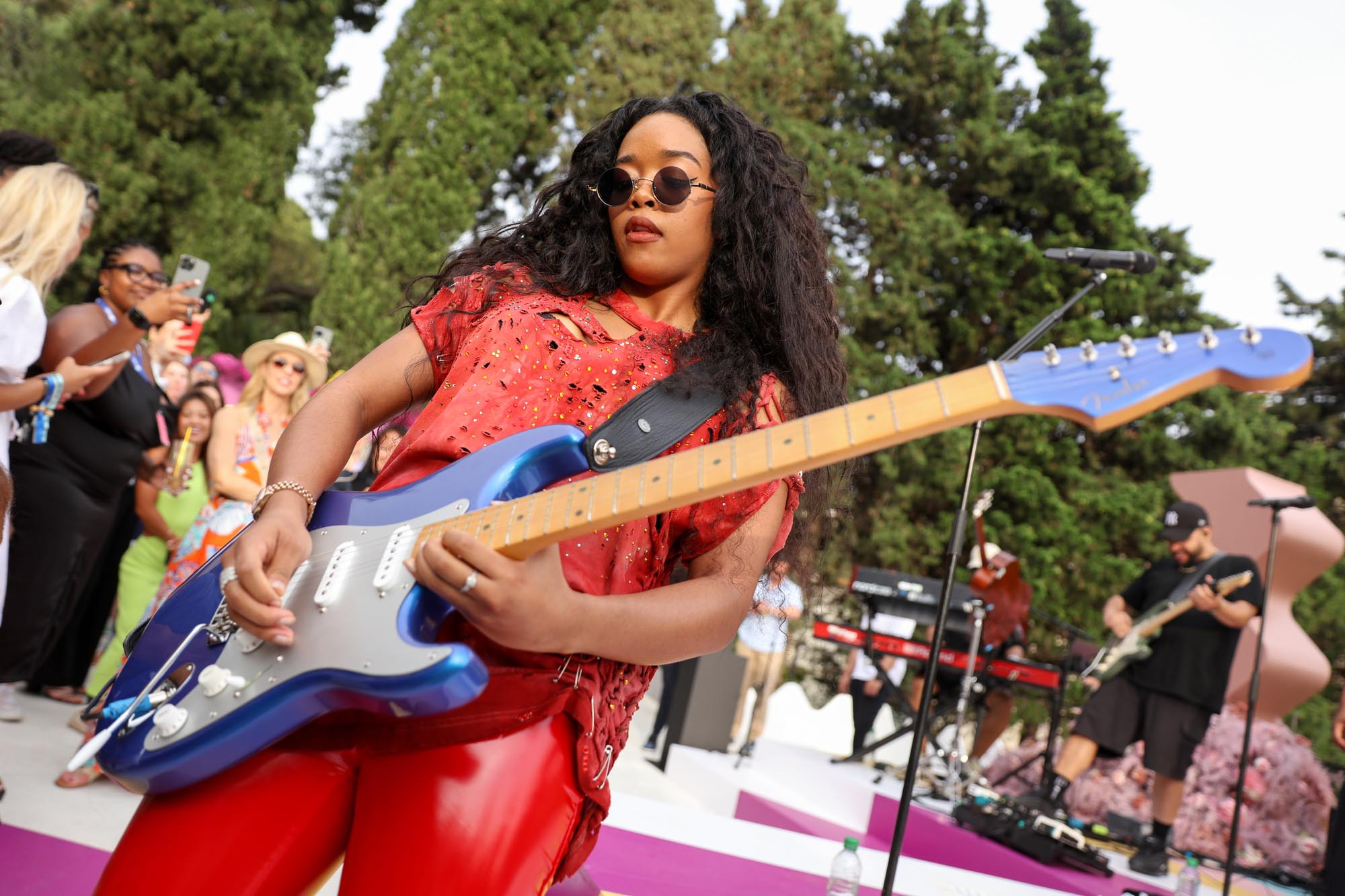 H.E.R. performing at Spotify event in Cannes, known for her R&B-infused guitar playing that ranges from delicate to Prince-like shredding.
H.E.R. performing at Spotify event in Cannes, known for her R&B-infused guitar playing that ranges from delicate to Prince-like shredding.
H.E.R. has maintained a relatively low profile, which makes each of her major public appearances, such as at the Grammys or the Super Bowl, all the more impactful and mind-blowing. While her vocal style is deeply rooted in classic R&B, her guitar playing is remarkably versatile, spanning delicate and fluid melodic accents to Prince-esque rock shredding. Her single “Hold On” perfectly showcases this range, featuring her doubling her own vocal melodies with a series of soaring, squealing guitar leads, a signature element of her style. “I also like to play my guitar like I’m singing,” she told Guitar World, emphasizing her vocal approach to guitar phrasing. “Sometimes, I like to sing and play my solos at the same time … even harmonizing my voice with my guitar.” In 2021, Fender honored her with a signature Stratocaster model, making her the first Black woman to achieve this recognition, a testament to her growing influence and impact on modern guitar music.
Key Tracks: “Hold On,” “Comfortable”
David Williams
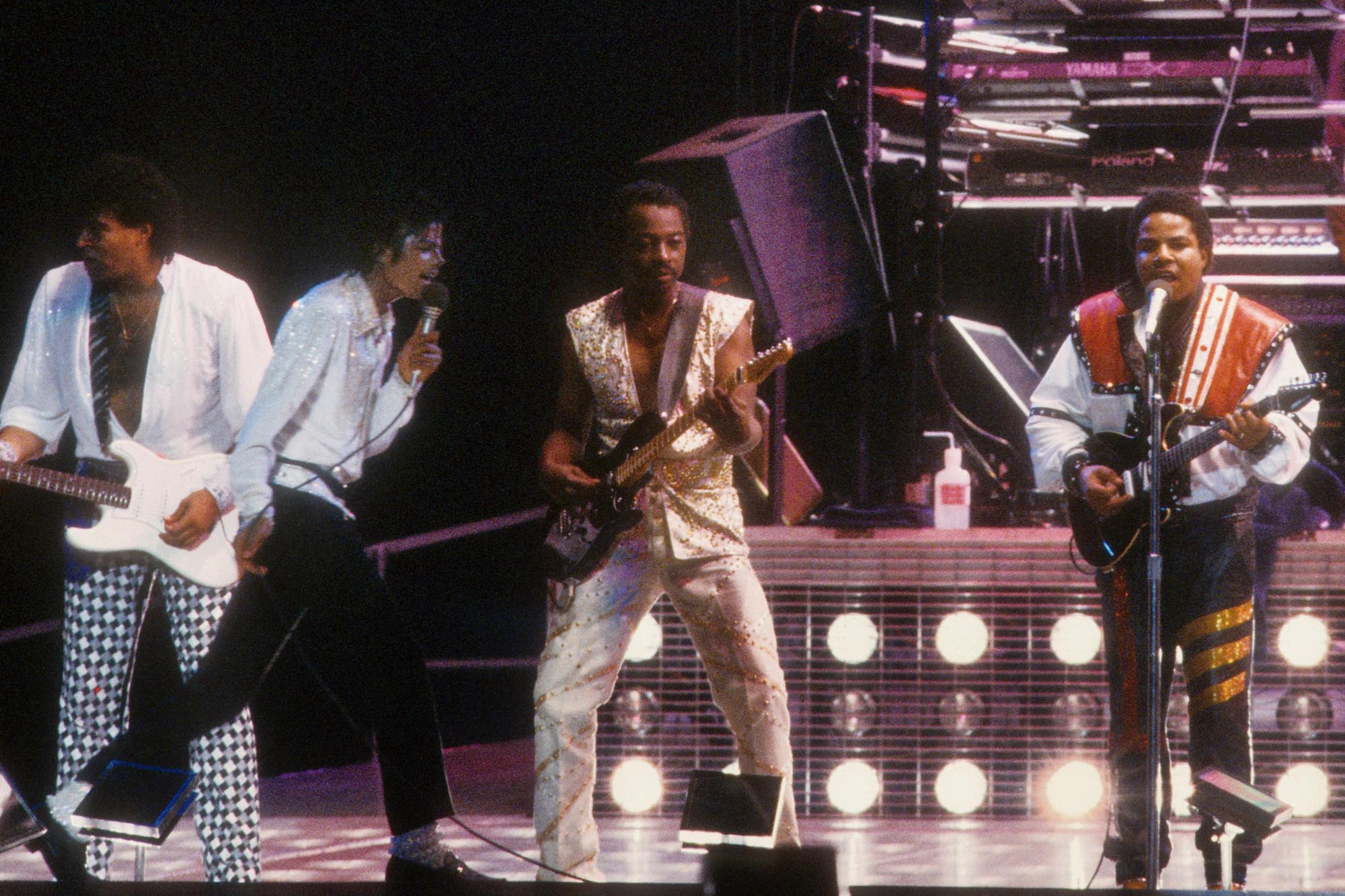 David Williams of The Jacksons performing in 1984, a session guitarist known for his spare but rhythmically seductive touches on pop hits like "Billie Jean".
David Williams of The Jacksons performing in 1984, a session guitarist known for his spare but rhythmically seductive touches on pop hits like "Billie Jean".
Despite his early love for jazz, David Williams made his most significant mark in a genre not typically known for instrumental showcases: 1980s pop music. His intentionally minimalist guitar touches are crucial to the rhythmic allure of Michael Jackson’s “Billie Jean,” Stevie Nicks’ “Stand Back,” and Diana Ross’ “Muscles.” A Vietnam veteran, Williams toured extensively with Jackson and Madonna and collaborated with a diverse array of artists from Chaka Khan to Kenny Loggins. He once described the “secret spice” he added to Top 40 hits: “You don’t need much of it, but the right amount gets the job done.” Williams’ understated yet highly effective guitar work became a defining characteristic of the sound of 80s pop, proving that sometimes less is indeed more. He passed away in 2009 at the age of 58, leaving behind a legacy of subtle but impactful guitar playing.
Key Tracks: “Billie Jean,” “Dirty Diana”
Etta Baker
 Etta Baker pictured in a portrait, a Piedmont blues legend known for her rolling, ragtime-influenced fingerpicking style.
Etta Baker pictured in a portrait, a Piedmont blues legend known for her rolling, ragtime-influenced fingerpicking style.
Etta Baker’s name is synonymous with Piedmont blues, a distinctive style characterized by its rolling, ragtime, and folk-influenced fingerpicking, originating along the East Coast in the early 20th century. Born in North Carolina in 1913 into a multi-racial family and raised in Virginia, Baker learned guitar from her father and frequently played at family dances in her youth. Her instrumental compositions, such as “One Dime Blues,” which appeared on a 1956 anthology, had a seismic impact on the folk music scene. Among those captivated listeners were Bob Dylan and Taj Mahal, the latter of whom would later record an album with Baker before her passing in 2006. Baker’s intricate fingerstyle guitar playing and her preservation of Piedmont blues traditions have solidified her legacy as a true blues icon.
Key Tracks: “One Dime Blues,” “Carolina Breakdown”
Gustavo Cerati
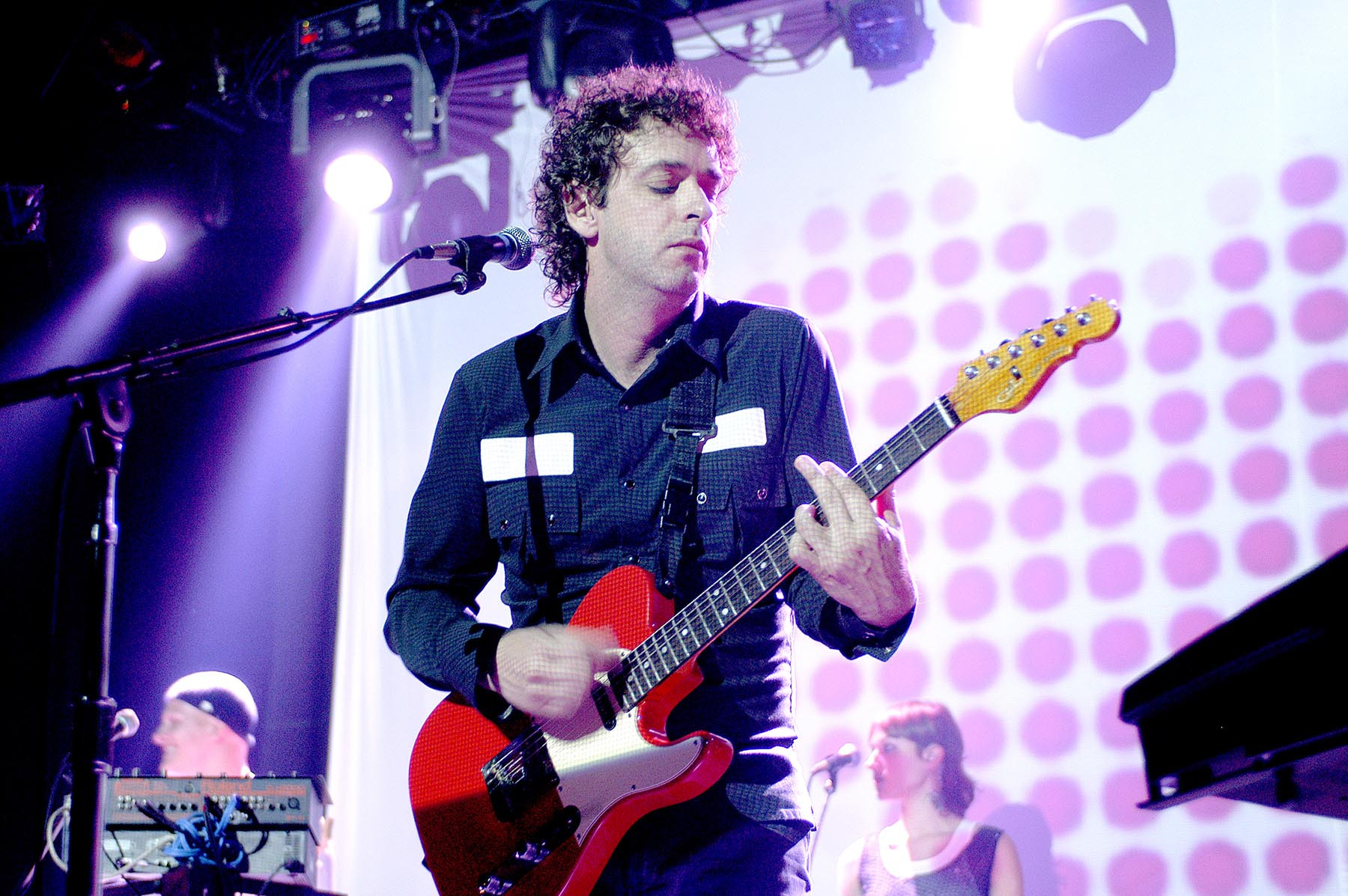 Gustavo Cerati performing on stage in 2003, an Argentine rock icon who transformed Latin rock with his majestic songs and extraordinary guitar playing.
Gustavo Cerati performing on stage in 2003, an Argentine rock icon who transformed Latin rock with his majestic songs and extraordinary guitar playing.
Gustavo Cerati’s profound impact on Latin rock is so significant that it’s easy to overlook just how extraordinary a guitar player he truly was. In the mid-1980s, the Argentine singer-songwriter spearheaded a pan-American rock en español boom with his band Soda Stereo, achieving massive success with anthemic hits like “De Música Ligera.” After Soda Stereo disbanded, Cerati explored electronic sounds and sampling. However, he dramatically returned to his guitar-god persona with his 2006 album Ahí Vamos, a powerful collection of songs drenched in raw electric riffs. Cerati tragically fell into a coma at the age of 50 and never recovered, but his image—smiling with pure joy as he unleashed a guitar solo on stage—remains indelibly etched in the collective memory of Latin music culture. His guitar playing was a vital element of his artistry and his lasting influence on Latin rock.
Key Tracks: “Canción Animal,” “La Excepción”
Barbara Lynn
 Barbara Lynn posing in 1964, an R&B singer and guitarist known for her soulful sound and left-handed guitar playing style.
Barbara Lynn posing in 1964, an R&B singer and guitarist known for her soulful sound and left-handed guitar playing style.
Sixteen-year-old Barbara Lynn delivered a stark warning to her boyfriend, Stank: “If you should lose me/You’ll lose a good thing.” The Beaufort, Texas, native transformed these words into music, using a right-handed guitar she taught herself to play left-handed. The resulting song, “You’ll Lose a Good Thing,” became an R&B Number One hit in 1962, launching an acclaimed career that has spanned over 60 years. Lynn’s largely self-penned songs have been covered by music legends such as the Rolling Stones, Aretha Franklin, Otis Redding, and Robert Plant, and sampled by the Beastie Boys and Moby. This widespread recognition speaks to the universal relatability and creative power of her songwriting and her distinctive guitar style, rooted in the blues and soul traditions of the Gulf Coast.
Key Tracks: “You’ll Lose a Good Thing,” “I’ll Suffer”
Steve Jones
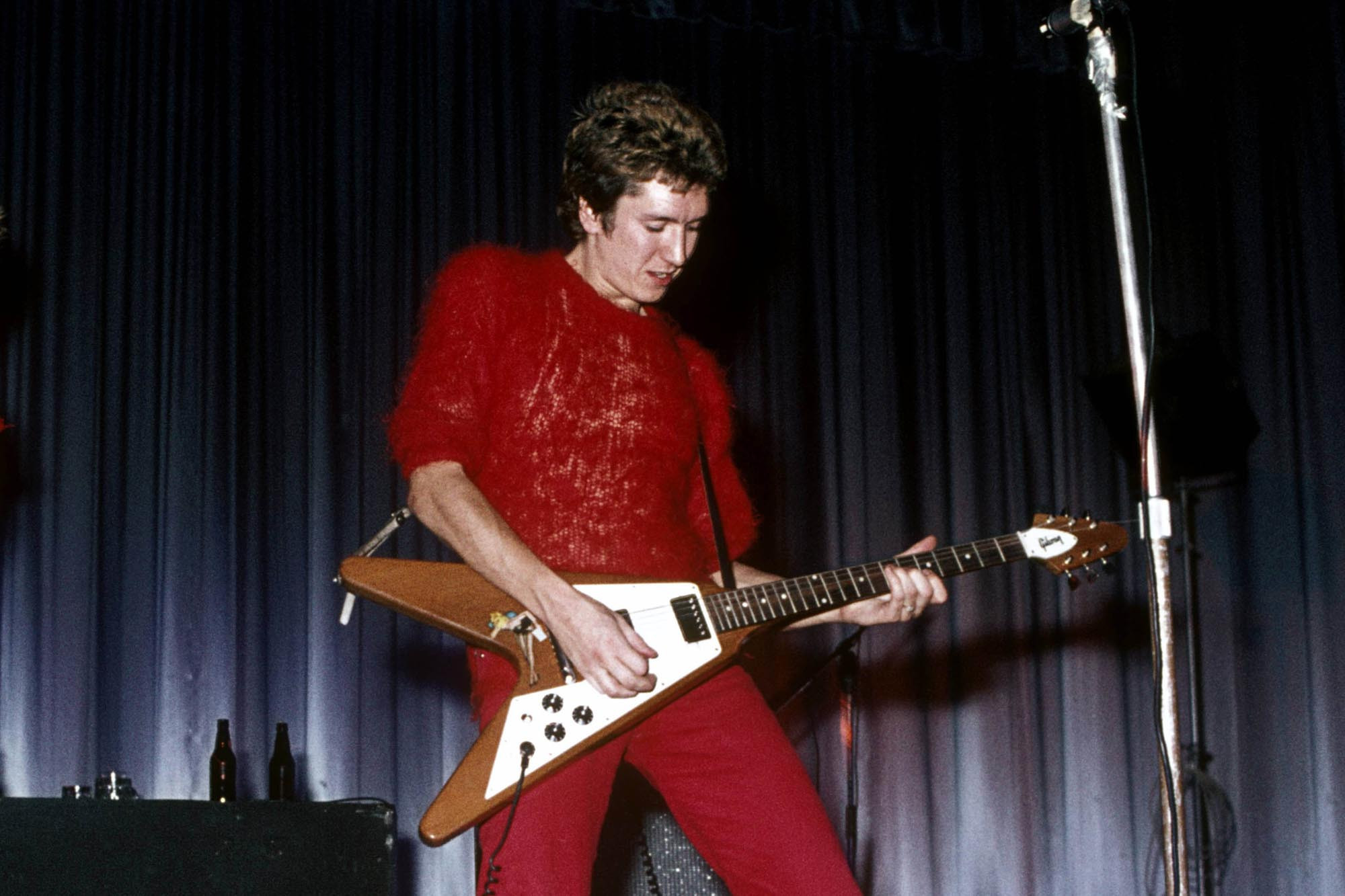 Steve Jones of the Sex Pistols performing live, known for his brutish power chords and flamboyant gutter-glam solos that defined punk rock guitar.
Steve Jones of the Sex Pistols performing live, known for his brutish power chords and flamboyant gutter-glam solos that defined punk rock guitar.
When Malcolm McLaren, manager of the New York Dolls turned Sex Pistols, gifted Steve Jones a white Les Paul Custom previously owned by Dolls’ guitarist Syl Sylvain, this instrument (or a similar model) became Jones’ signature weapon. Jones’ raw, brutish power chords and flamboyant, gutter-glam-inspired solos perfectly mirrored the sneering, confrontational attitude of Johnny Rotten and set a new standard for punk rock guitar playing. His legacy was solidified with the indelible riffs on the Sex Pistols’ seminal 1977 album, Never Mind the Bollocks…, which has inspired generations of guitarists from Slash to Billie Joe Armstrong. It was an attitude as much as a refined technique that defined Jones’ playing. As he famously told a journalist during his Sex Pistols days, “Actually, we’re not into music. We’re into chaos.” This rebellious spirit is at the heart of his influential guitar style.
Key Tracks: “God Save the Queen,” “Pretty Vacant”
Glenn Branca
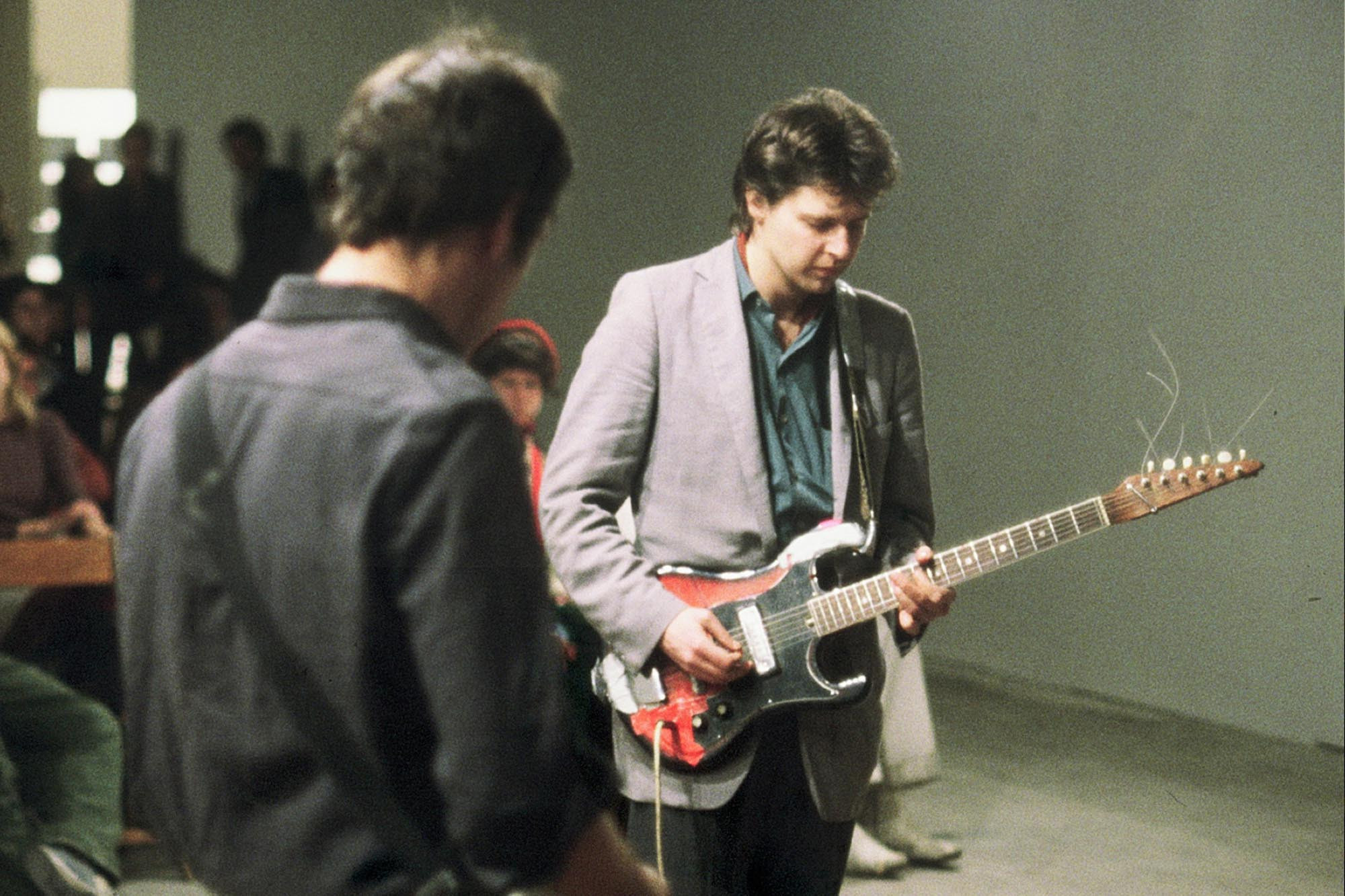 Glenn Branca pictured in a promotional shot, a central figure in New York's No Wave movement who expanded the guitar's symphonic possibilities.
Glenn Branca pictured in a promotional shot, a central figure in New York's No Wave movement who expanded the guitar's symphonic possibilities.
Glenn Branca, a pillar of New York’s post-punk No Wave movement, dedicated his career to establishing the guitar as a symphonic instrument. He often employed custom tunings, notably his “harmonic series” tuning, and modified guitars to operate in different registers and produce diverse tonalities. Branca composed for guitar ensembles that sometimes swelled to include up to 100 players. His droning, powerful Symphony No. 1, recorded in 1981, featured Thurston Moore and Lee Ranaldo of Sonic Youth within the orchestra. Branca also released Sonic Youth’s debut album on his Neutral label, demonstrating his keen eye for spotting other musical revolutionaries. “I’ve got so many ideas about music that I haven’t even begun to work on,” he told Esquire in 2016. “If I lived to 200, I wouldn’t finish my work.” His expansive vision and experimental approach redefined the possibilities of the guitar in ensemble settings.
Key Tracks: “Light Field (In Consonance),” “Velvets and Pearls”
El Kempner
 El Kempner of Palehound performing live in 2016, an indie-powerhouse guitarist known for versatility and electrifying riffs.
El Kempner of Palehound performing live in 2016, an indie-powerhouse guitarist known for versatility and electrifying riffs.
Long before El Kempner launched Palehound, the critically acclaimed indie rock project that has recently opened for boygenius, they were a seven-year-old learning guitar by strumming their dad’s guitar with a marker cap. Guitar has remained a guiding force in the Boston-based musician’s life. Electrifying riffs, elevated by Kempner’s musical dexterity, drive vibrant tracks like “The Clutch” from Palehound’s recent album, Eye on the Bat. What truly distinguishes the 29-year-old’s refined skills is their versatility. Kempner is equally comfortable rocking out on their beloved Stratocaster, performing delicate acoustic fingerpicking, or crafting swirling arpeggios. This range and adaptability make Kempner a compelling and dynamic guitarist in the contemporary indie rock scene.
Key Tracks: “The Clutch,” “Independence Day”
Fred ‘Sonic’ Smith and Wayne Kramer
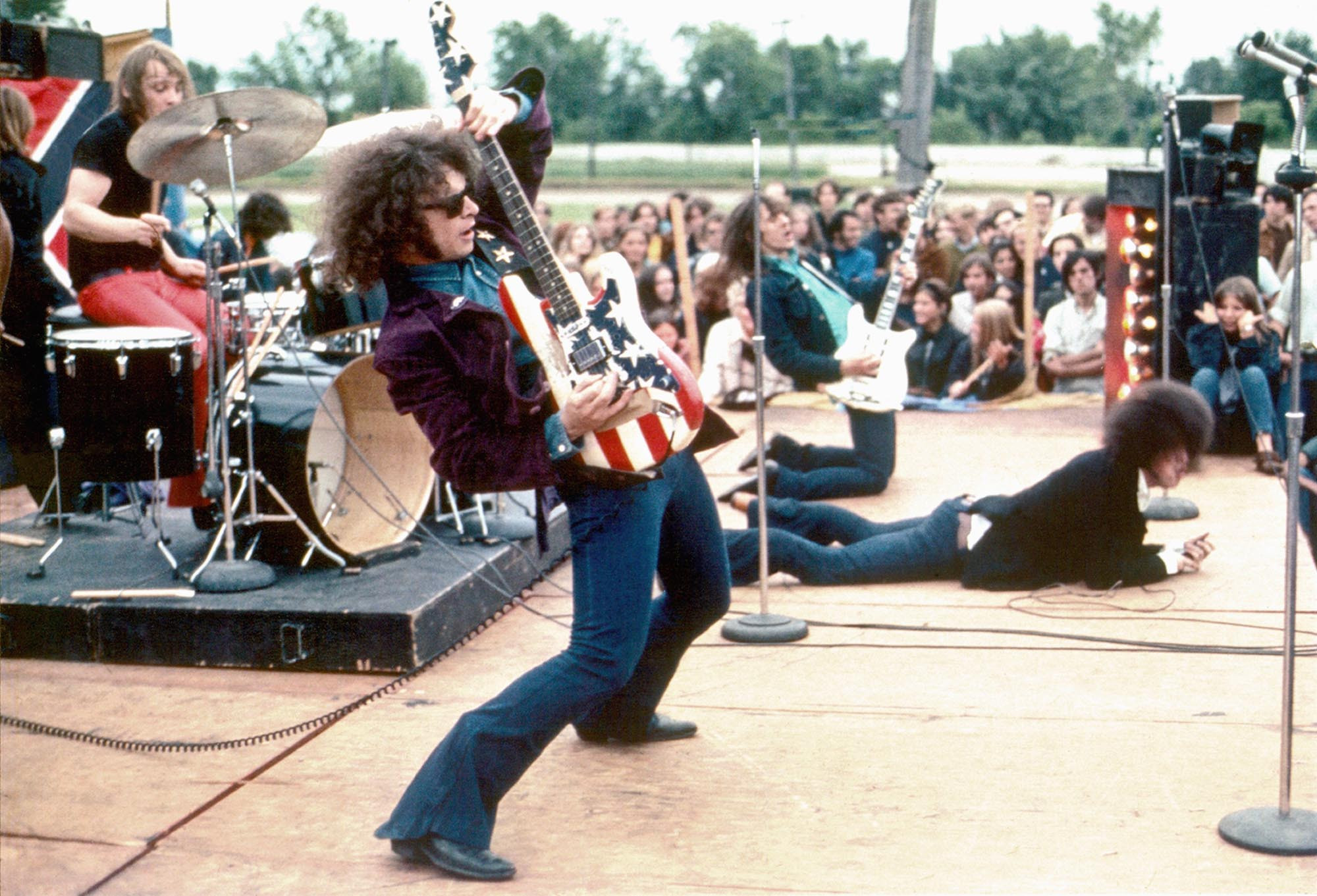 Wayne Kramer and Fred "Sonic" Smith of MC5 performing live in 1969, a Detroit guitar tandem known for their high-energy jams and proto-punk sound.
Wayne Kramer and Fred "Sonic" Smith of MC5 performing live in 1969, a Detroit guitar tandem known for their high-energy jams and proto-punk sound.
Forged in the crucible of 1960s Detroit, the MC5 guitar partnership of Wayne Kramer and Fred “Sonic” Smith functioned like the pistons of a high-performance engine. Blending influences from Chuck Berry and early Motown with an emerging interest in free jazz, the duo could propel their band’s legendary high-energy jams into expansive sonic territories while maintaining a solid rhythmic foundation. “If you play with another guitar player long enough, you exhaust everything you know, and then you start playing what you don’t know, and you get into something good,” Kramer explained in a 2018 interview. “We just found that we could play syncopated rhythm parts simultaneously, and they would lock in perfectly, or we could solo simultaneously and they’d still lock in.” Their telepathic guitar interplay and raw, proto-punk energy were central to the MC5’s explosive sound and enduring influence.
Key Tracks: “Looking at You,” “Poison”
Marv Tarplin
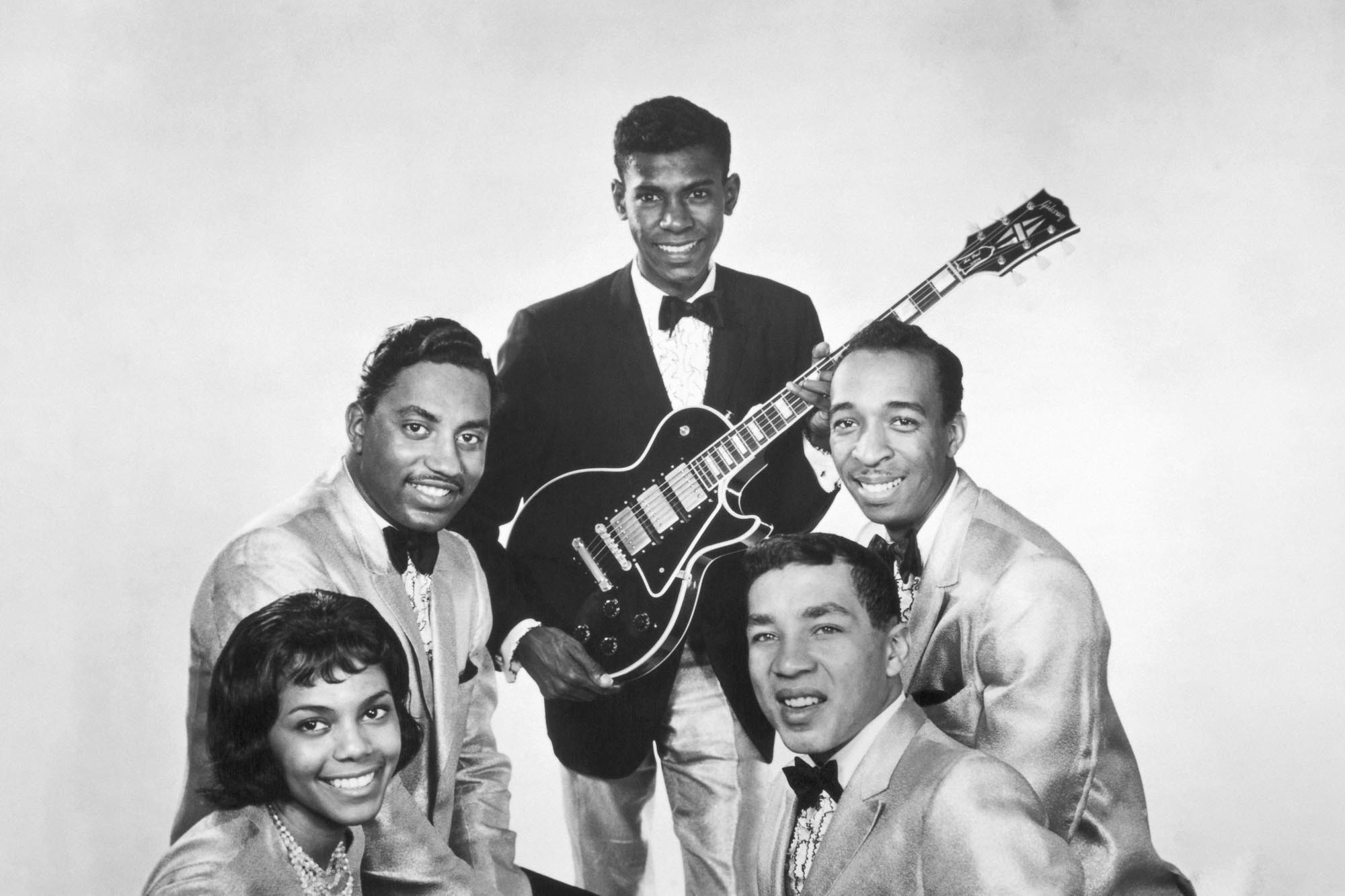 Marv Tarplin of Smokey Robinson and The Miracles pictured in 1962, a Motown guitarist whose playing and composing were key to the group's success.
Marv Tarplin of Smokey Robinson and The Miracles pictured in 1962, a Motown guitarist whose playing and composing were key to the group's success.
The guitar playing and songwriting of Atlanta-born and Detroit-raised Marv Tarplin became integral to the success of Smokey Robinson and the Miracles soon after Robinson personally selected him as the group’s guitarist in the 1960s. Tarplin’s versatility perfectly suited the diverse demands of Motown, from his driving chords on “Going to a Go-Go” to the delicate 12-string acoustic work on “You Really Got a Hold on Me.” His experimentation with the chord structure of Harry Belafonte’s “Day-O (The Banana Boat Song)” led him to write the core of the Miracles’ smash hit “The Tracks of My Tears.” He continued his collaboration with Robinson after the Miracles disbanded. The subtle, intricate guitar lines he added to Robinson’s 1979 solo single “Cruisin’” gave the track a timeless quality, contributing to its rise into the Billboard Hot 100’s Top Five. Tarplin’s musical contributions were essential to the signature sound of Smokey Robinson and the Miracles.
Key Tracks: “The Tracks of My Tears,” “Cruisin’”
Joseph Spence
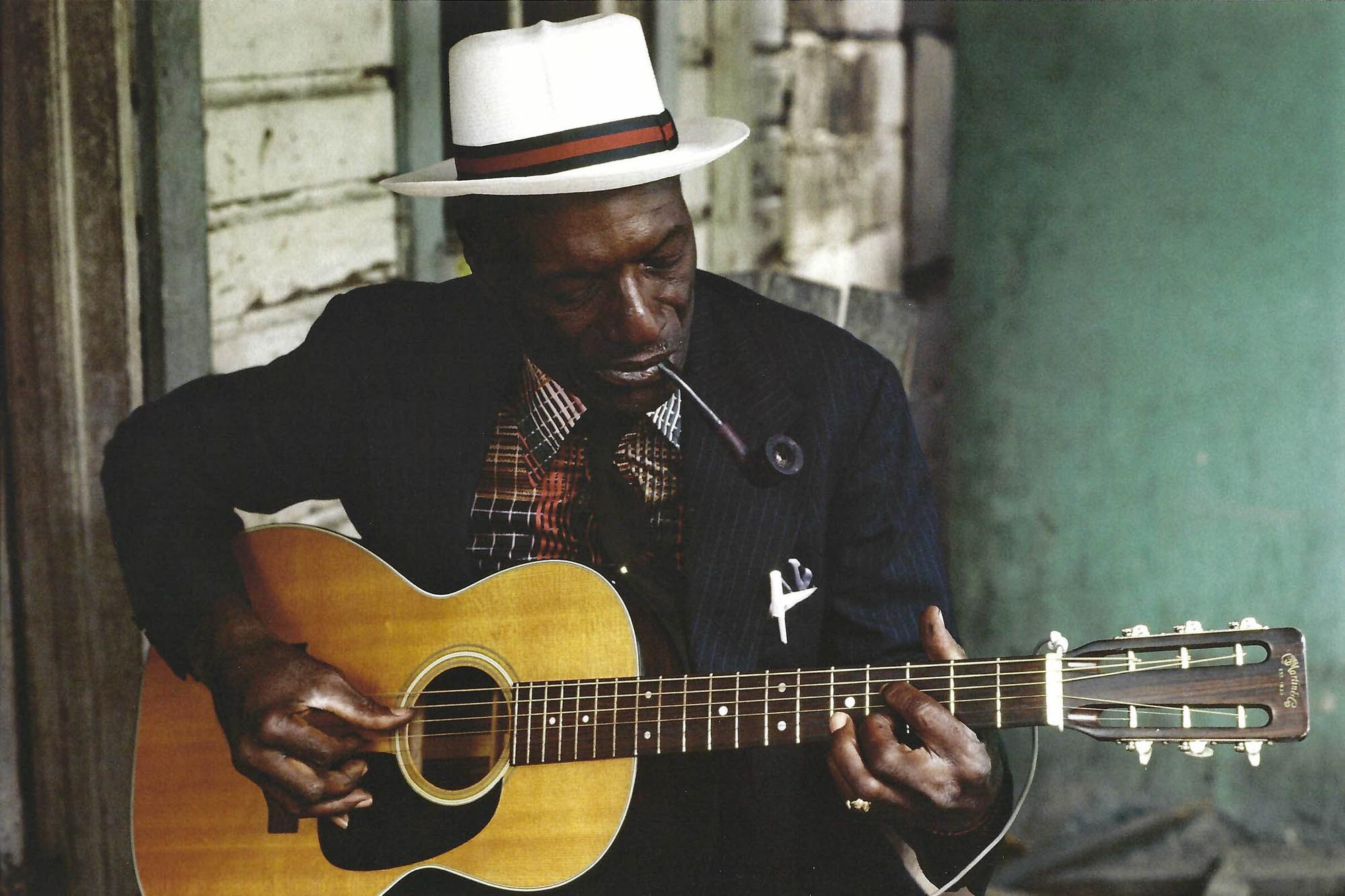 Joseph Spence pictured in a candid shot, a Bahamian guitarist known for his pointillistic fingerpicking style that influenced folk and beyond.
Joseph Spence pictured in a candid shot, a Bahamian guitarist known for his pointillistic fingerpicking style that influenced folk and beyond.
In 1958, musicologists Sam Charters and Ann Danberg Charters were in the Bahamas seeking musicians to record when they encountered Joseph Spence. His music was so rich and full that from a distance, they mistakenly believed they were hearing two guitarists playing simultaneously. “He often seemed to be improvising in the bass, the middle strings, and the treble at the same time,” Sam Charters noted in the liner notes to Joseph Spence: The Complete Folkways Recordings 1958. Spence’s pointillistic, sharply angled fingerpicking style, applied across a wide range of musical forms from blues to spirituals to calypso, exerted a profound influence on the folk music movement and beyond. The Grateful Dead transformed Spence’s highlight “We Bid You Goodnight” into a staple live set closer, and the Beach Boys’ Pet Sounds classic “Sloop John B” owes a clear debt to Spence’s version of the song. His unique guitar style and eclectic repertoire have made him a highly revered and influential figure in folk and roots music.
Key Tracks: “Brownskin Girl,” “Jump in the Line”
Molly Tuttle
 Molly Tuttle performing live in 2014, a bluegrass innovator known for her acoustic flatpicking and Grammy-nominated artistry.
Molly Tuttle performing live in 2014, a bluegrass innovator known for her acoustic flatpicking and Grammy-nominated artistry.
Even before sweeping bluegrass awards ceremonies, California-raised, Nashville-based bluegrass innovator Molly Tuttle and her band Golden Highway were making history in roots music. Her acoustic flatpicking style, influenced by a diverse range of guitarists from Tony Rice to Joni Mitchell to Clarence White, is deeply rooted in tradition yet unbound by it. Earlier this year, she achieved a historic milestone by becoming the first bluegrass act ever to receive a Best New Artist Grammy nomination, signaling the genre’s continued evolution and Tuttle’s central role in driving it forward. “Our generation of bluegrass players are really pushing in some new directions,” Tuttle told Rolling Stone in January. “I feel lucky to be part of this scene that’s breaking down barriers.” Her innovative approach and technical brilliance are pushing the boundaries of bluegrass guitar and earning her widespread recognition.
Key Tracks: ‘Take the Journey,” “El Dorado”
James Blood Ulmer
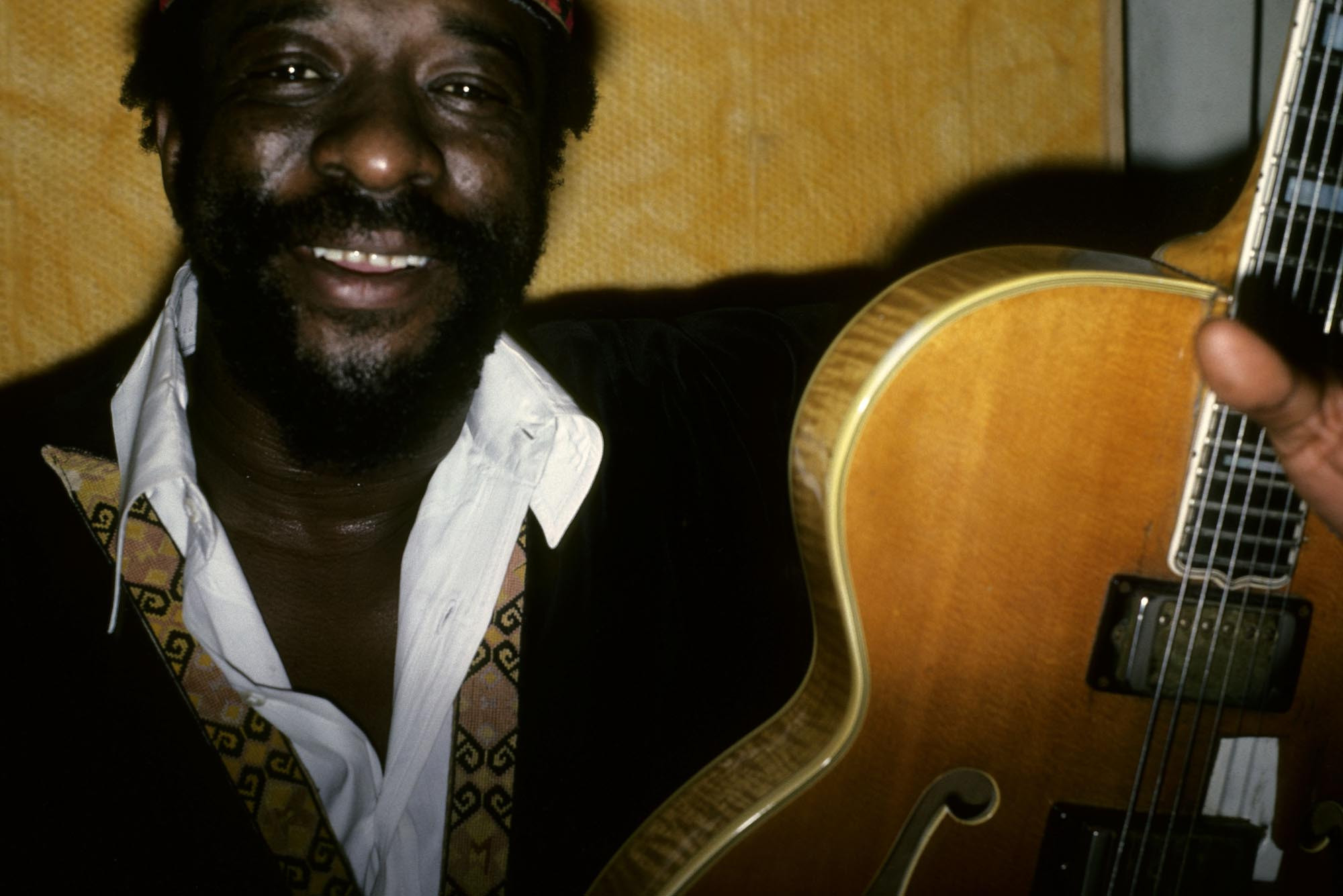 James Blood Ulmer pictured in a portrait, a free jazz and blues innovator known for his skronky riffs and influence on experimental music.
James Blood Ulmer pictured in a portrait, a free jazz and blues innovator known for his skronky riffs and influence on experimental music.
James Blood Ulmer, initially playing soul jazz and later as a key foil to free jazz icon Ornette Coleman’s melodic explorations, forged a groundbreaking guitar style by fusing generations of blues, funk, and jazz into shimmering sonic textures, skronky riffs, and jittery solos. On albums like Tales of Captain Black and Odyssey, his stinging guitar tone became a major influence on the 1970s and 80s downtown New York experimental music scene, impacting artists from Vernon Reid (who produced Ulmer’s acclaimed 2000s blues albums) to no-wave bands like DNA and Mars. As Vernon Reid aptly described, “James Blood Ulmer is fully aware, theoretically and idiomatically — he’s just never been constrained by those concerns. He is a rock. He is unapologetically himself. He is the blues. Itself. Not its rules.” Ulmer’s iconoclastic approach and unique sound have made him a hugely influential figure in experimental and avant-garde guitar music.
Key Tracks: “Theme from Captain Black,” “Timeless”
Courtney Barnett
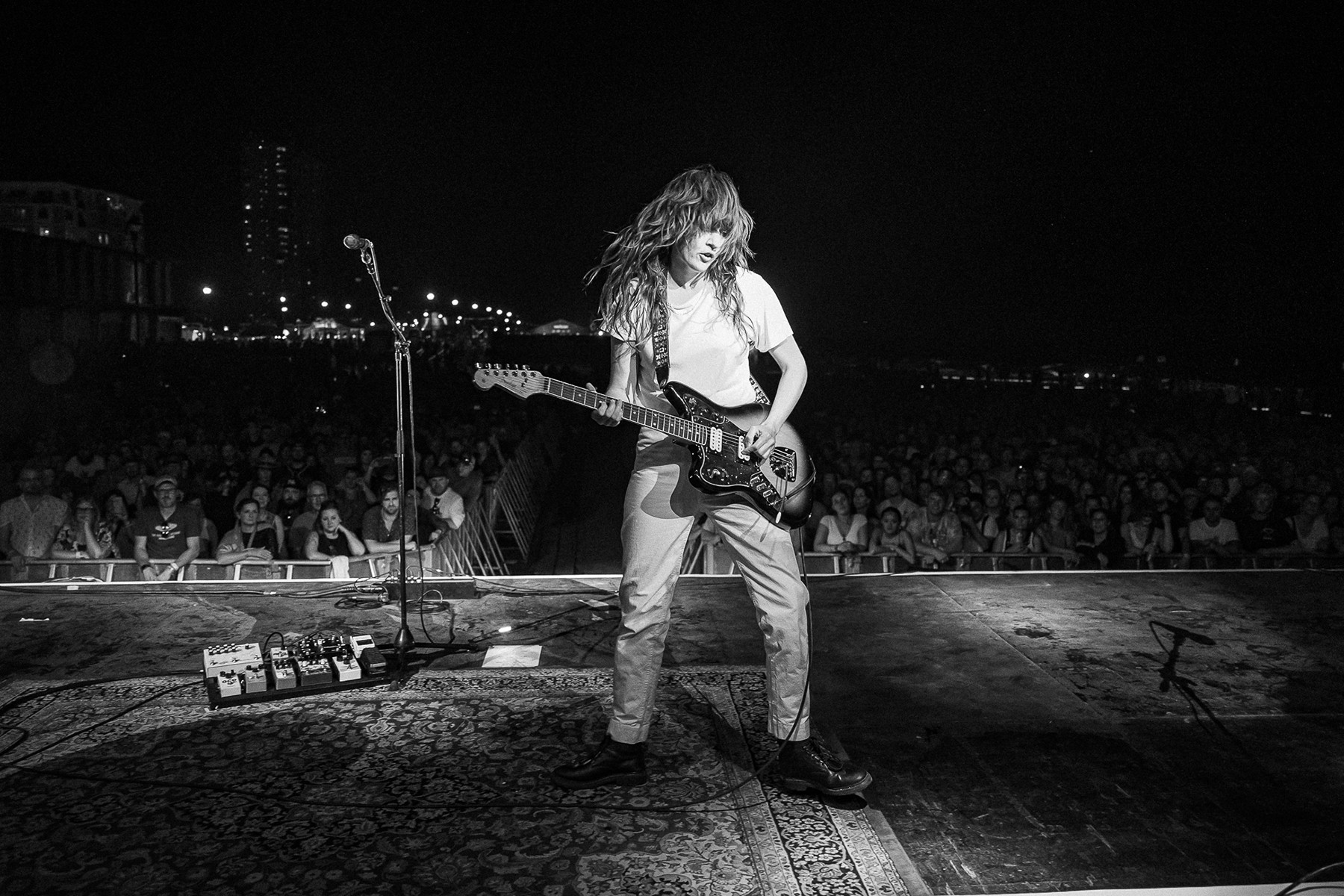 Courtney Barnett performing live, an indie-rock singer-songwriter known for dynamic shifts between intricate fingerpicking and garage-rock solos.
Courtney Barnett performing live, an indie-rock singer-songwriter known for dynamic shifts between intricate fingerpicking and garage-rock solos.
Indie-rock singer-songwriter Courtney Barnett’s ability to seamlessly transition between intricate, melodic fingerpicking and frenetic, garage-rock-inspired solos greatly enhances the dynamism of her witty and insightful storytelling. “It sounds like you’re driving across a highway and it’s sunny,” Barnett described “Write a List of Things to Look Forward To” from her 2021 album, Things Take Time, Take Time, in a Rolling Stone interview. This perfectly encapsulates how Barnett’s guitar playing complements her often-lilting, liberating songs. On Lotta Sea Lice, her collaborative album with Kurt Vile (also featured on this list), the musical chemistry between the two guitarists is dazzling, as their guitars and vocals intertwine spontaneously and seamlessly. Barnett’s guitar work is an essential element of her engaging and distinctive musical voice.
Key Tracks: “Turning Green,” “Over Everything,” “Pedestrian at Best”
Glenn Tipton and K.K. Downing
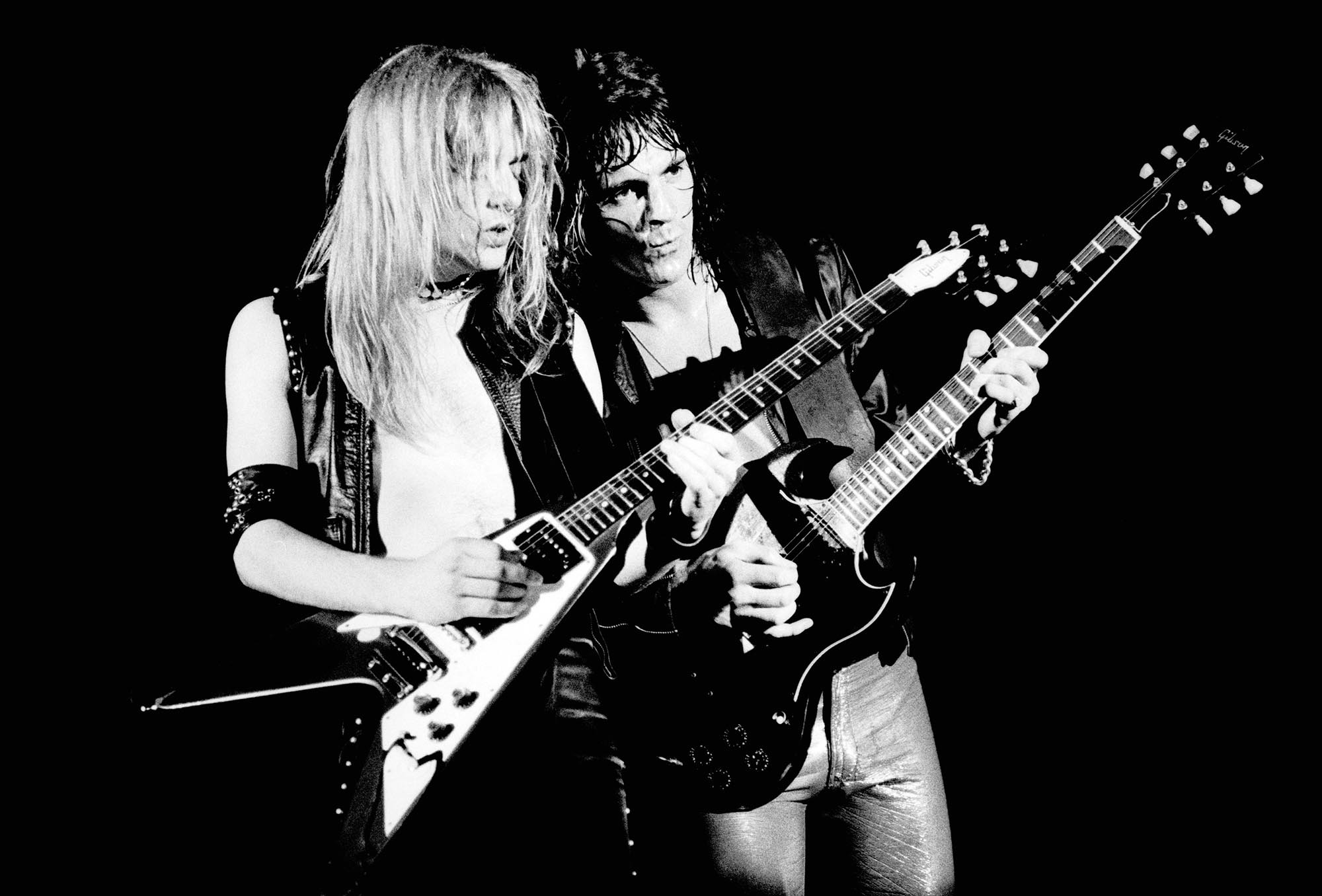 K.K. Downing and Glenn Tipton of Judas Priest performing in 1978, a heavy metal guitar duo who redefined "heavy" with their twin-guitar attack.
K.K. Downing and Glenn Tipton of Judas Priest performing in 1978, a heavy metal guitar duo who redefined "heavy" with their twin-guitar attack.
After witnessing the sonic impact that Black Sabbath, Led Zeppelin, and Deep Purple achieved with a single guitarist, Judas Priest redefined the concept of “heavy” in the mid-1970s with two: K.K. Downing and Glenn Tipton. Unlike bands like the Rolling Stones and the Kinks who typically divided guitar duties into rhythm and lead, Tipton and Downing doubled down on riffs, traded blistering solos, and embraced harmony leads on Judas Priest’s high-octane, motorcycle-revving anthems. Their innovative give-and-take approach became the foundational template for countless two-guitar heavy metal bands that followed, including Iron Maiden, Metallica, and Slayer. As Slayer’s Kerry King observed, “You can almost always tell that if it’s Tipton, it’s super-fucking tasty. If it’s K.K., it’s a more edgy, almost punky kind of vibe, which is a great mix.” This contrasting yet complementary guitar dynamic was crucial to Judas Priest’s pioneering heavy metal sound.
Key Tracks: “Victim of Changes,” “Breaking the Law,” “The Hellion/Electric Eye”
Lzzy Hale
 Lzzy Hale of Halestorm performing live, a hard rock goddess known for her powerful voice and aggressive, rhythmic guitar style.
Lzzy Hale of Halestorm performing live, a hard rock goddess known for her powerful voice and aggressive, rhythmic guitar style.
Lzzy Hale is rightfully celebrated as a hard rock goddess for her powerhouse vocals alone. However, she is also a fiercely talented guitarist, known for her aggressively rhythmic slap style that perfectly complements Halestorm’s lead guitarist Joe Hottinger. Hale is also capable of impressive shredding—note how she mirrors the vocal melody of “I Miss the Misery” on her guitar. Her influence on 21st-century guitar rock is so significant that Gibson chose her as their first female brand ambassador. The company even designed a Hale signature model of their iconic Explorer guitar, which she plays onstage and gifts to fellow musicians, from Demi Lovato to Daniela Villarreal of The Warning. “The people at Gibson keep telling me the demographic that buys the most electric guitars right now are female,” Hale told Rolling Stone. “The wave is coming whether anybody likes it or not.” Hale’s prominence is a testament to the growing influence of women in rock guitar.
Key Tracks: “I Miss the Misery,” “The Steeple”
Thomas McClary
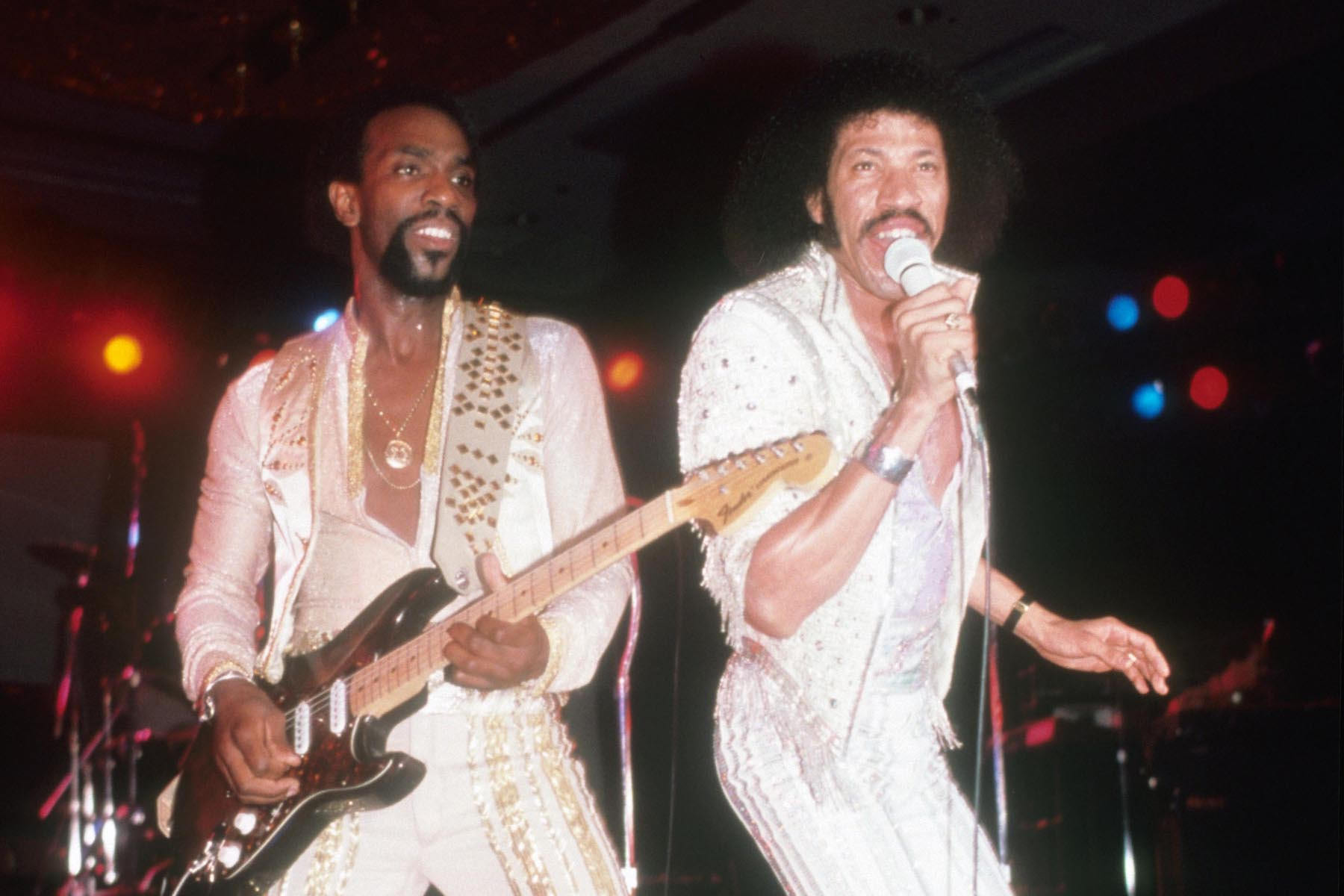 Thomas McClary of The Commodores pictured in 1978, known for blending glam and blues guitar styles in the funk and soul group.
Thomas McClary of The Commodores pictured in 1978, known for blending glam and blues guitar styles in the funk and soul group.
As one of the first Black students to integrate Florida public schools, Eustis, Florida-born Thomas McClary, whose first instrument was the ukulele, was accustomed to forging his own path. He attended Tuskegee Institute in Alabama, where he co-founded the Commodores with singer Lionel Richie. The group uniquely merged funk, soul, gospel, and country influences, achieving crossover appeal with both Black and white audiences. McClary’s guitar style, a blend of glam grandeur and blues grit, on songs like “Easy” was instrumental in shaping the sound of 1980s crossover music. “I would listen to Santana, Jimi Hendrix, Albert King, James Taylor, and Crosby, Stills, Nash, and Young,” he recalled. “I thought it would be really great to mesh those guys together to have a really raunchy, raw, authentic sound that could be appealing to everybody.” McClary’s vision and guitar work were crucial to the Commodores’ distinctive and widely loved sound.
Key Tracks: “Easy,” “Brick House”
Steve Hackett
Genesis were a relatively obscure art-rock band until guitarist Steve Hackett joined in 1971, replacing founding member Anthony Phillips. Hackett made an immediate impact by introducing the band to his two-hand tapping technique, which they featured on 1971’s Nursery Cryme, years before Eddie Van Halen popularized it for a wider audience. A few years later, he laid down an epic and emotionally soaring guitar solo on their masterpiece “Firth of Fifth,” widely regarded as one of the most beautiful pieces of music ever recorded on a prog-rock album. He left Genesis in 1977 to pursue a successful solo career that continues to this day. “I’m very happy to have freed up guitarists to play dazzling solos,” Hackett reflected, “and come up with things that would only be dreamt up at one time.” His innovative techniques and melodic sensibilities greatly enriched Genesis’ sound and influenced generations of guitarists.
Key Tracks: “Horizons,” “Firth of Fifth”
Kurt Vile
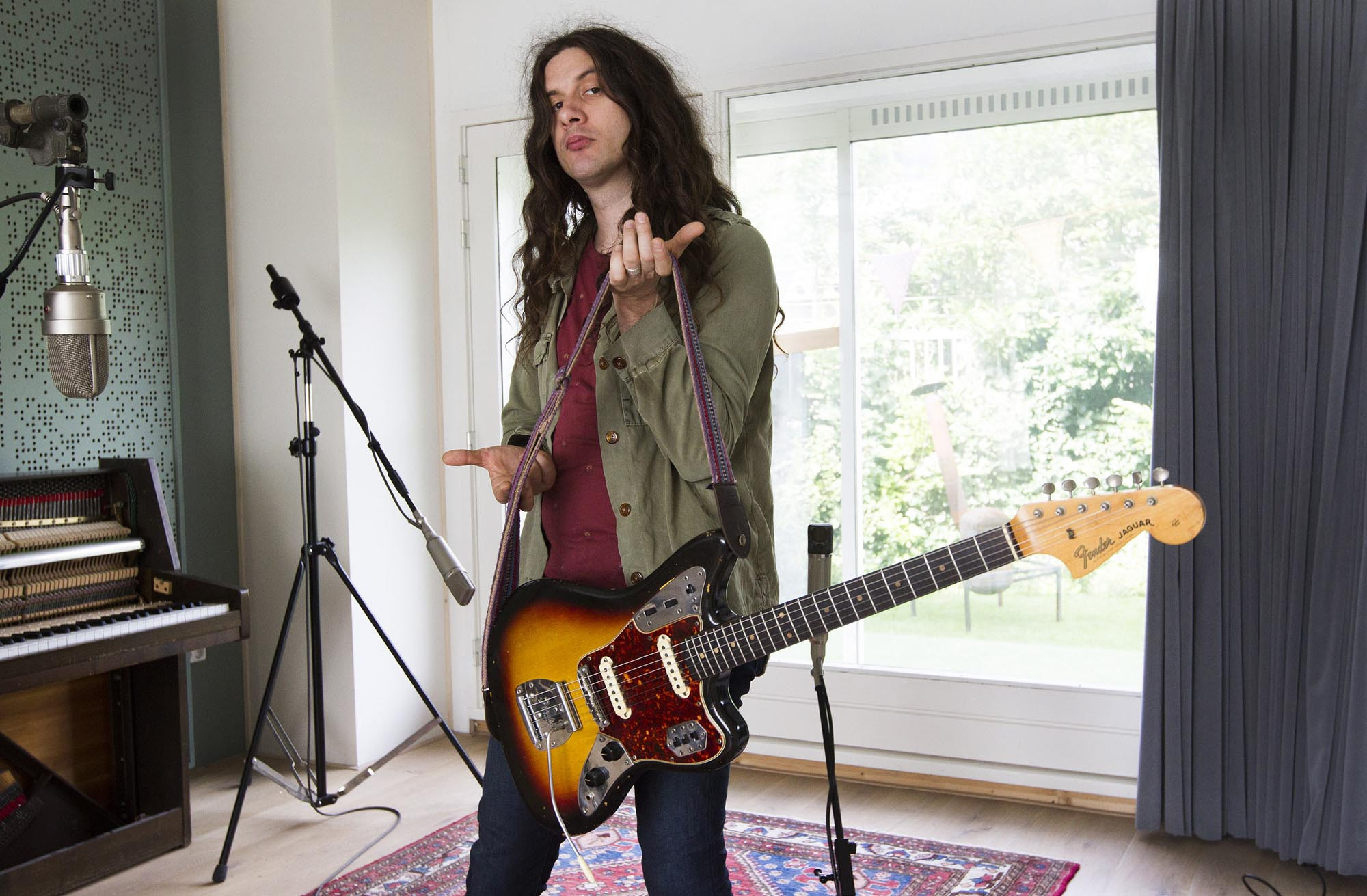 Kurt Vile posing with a Fender Jaguar guitar in 2015, an indie-rock guitarist known for his chilled-out drones and intricate yet melodic solos.
Kurt Vile posing with a Fender Jaguar guitar in 2015, an indie-rock guitarist known for his chilled-out drones and intricate yet melodic solos.
Kurt Vile often projects an image of an easygoing slacker, but he is a deeply serious and accomplished guitarist. His distinctive style, combining relaxed drones with intricate yet melodic solos, is partly rooted in his early experiences with the banjo, which his parents gave him as a teenager after he initially asked for a guitar. “Banjos are in an open tuning, and they’ve got that high drone string,” the Philadelphia-based musician explained in a 2018 interview. “It’s not like you’d even think about that when you’re playing as a kid, but I came to really like that ethereal drone.” Throughout his career, Vile has incorporated a wide array of musical influences, synthesizing them into his signature laid-back yet subtly virtuosic style. His guitar playing is characterized by its relaxed feel and melodic complexity, making him a unique and influential figure in indie rock guitar.
Key Tracks: “Pretty Pimpin,” “Wakin on a Pretty Day”
Keiji Haino
 Keiji Haino posing in Tokyo, a Japanese noise musician known for his cathartic and experimental guitar performances.
Keiji Haino posing in Tokyo, a Japanese noise musician known for his cathartic and experimental guitar performances.
Japanese musician Keiji Haino’s free-form solo performances are intense and noisy explorations in catharsis. In these performances, it’s often unclear whether he is simply playing the guitar or conducting an exorcism upon it. In ensemble settings, such as the late-1990s group Aihiyo, whose self-titled debut is beautifully raw and deeply emotive, Haino’s range is evident. He can shift from soothing with soft, shimmering chords to assaulting the listener’s eardrums with squalls of feedback and fuzz in an instant. “People practice really hard because they want people to check them out,” he told Vice Japan. “And then they say it’s improvisation. That drives me nuts.” Haino’s uncompromising and intensely personal approach to guitar playing places him firmly in the realm of experimental and noise music pioneers.
Key Tracks: “A Shredded Coiled Cable Within This Cable Sincerity Could Not be Contained,” “Why in the Courtesy of the Prey Always Confused With the Courtesy of the Hunters Pt. 1”
Lucy Dacus
 Lucy Dacus performing live, an indie singer-songwriter for whom the guitar is as essential as her voice, known for her understated arrangements.
Lucy Dacus performing live, an indie singer-songwriter for whom the guitar is as essential as her voice, known for her understated arrangements.
For Lucy Dacus, the guitar is as fundamental to her musical expression as her voice, even if her guitar playing often receives less attention than her sharp and insightful lyrics. From her pulsing rhythm guitar part on the standout 2016 track “I Don’t Wanna Be Funny Anymore” to her contributions in the indie supergroup boygenius, Dacus’s guitar arrangements are an understated yet crucial component of her artistic gifts. Live performances of her 2018 fan favorite “Night Shift” often begin quietly, with Dacus strumming alone. As the song progresses, her longtime lead guitarist Jacob Blizard introduces distorted textures, but Dacus remains locked in rhythmically, never faltering through the song’s dynamic shifts, culminating in a crashing, cathartic finale. Her guitar playing provides the essential rhythmic and harmonic foundation for her emotionally resonant songwriting.
Key Tracks: “Night Shift,” “I Don’t Wanna Be Funny Anymore”
José Feliciano
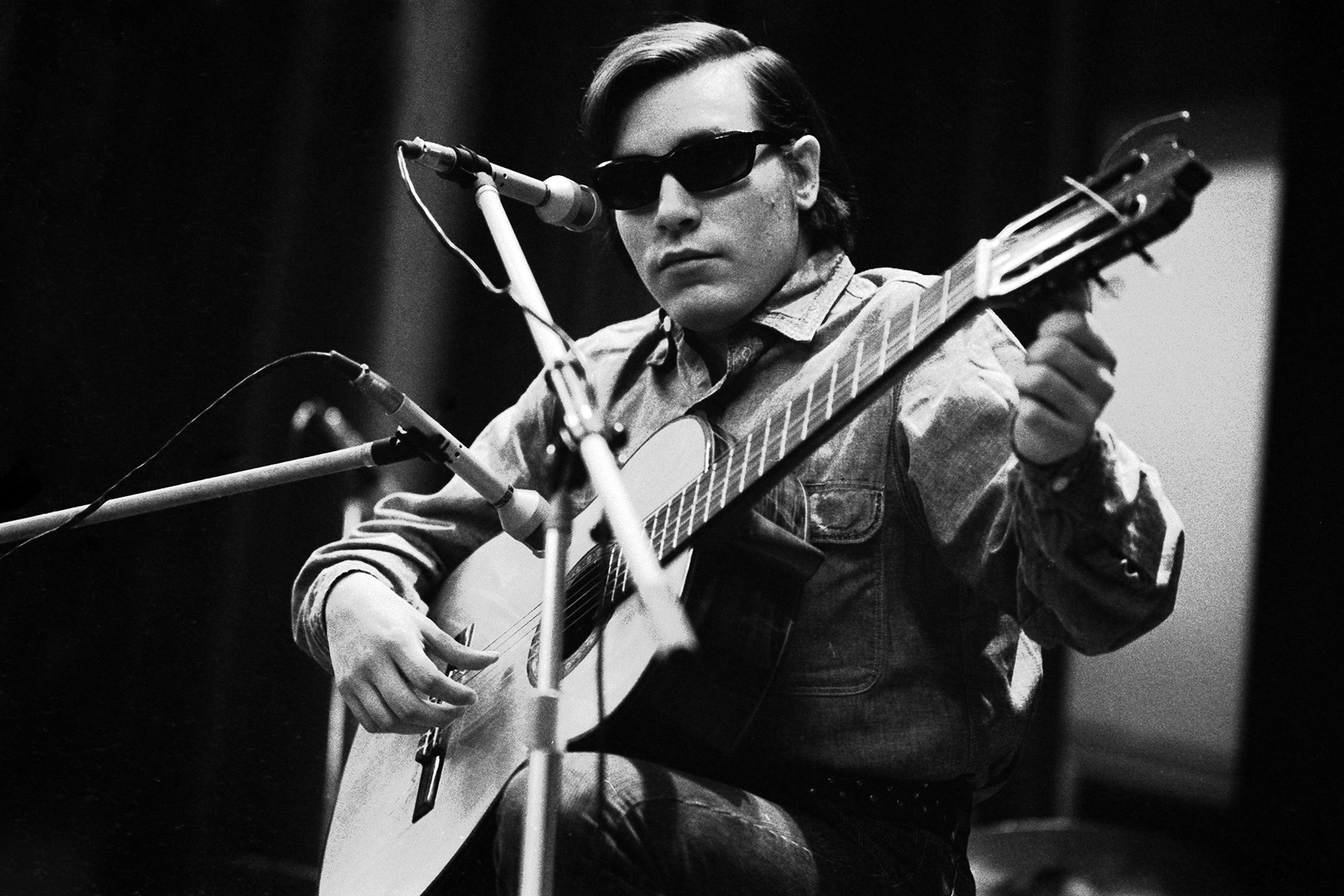 José Feliciano performing in 1973, a Puerto Rican virtuoso known for his lyrical and ferocious acoustic guitar playing, blending styles from rock to bossa nova.
José Feliciano performing in 1973, a Puerto Rican virtuoso known for his lyrical and ferocious acoustic guitar playing, blending styles from rock to bossa nova.
To think of José Feliciano solely as the artist behind the holiday classic “Feliz Navidad” would be a profound underestimation of his musical artistry. Born blind, Feliciano became an acoustic guitar virtuoso in his teens. His playing is alternately lyrical and fiery, deeply imbued with the boleros and folk songs of his Puerto Rican heritage. His eclectic fusion of styles—rock, jazz, soul, bossa nova—radically altered the sound of mainstream pop-rock in the 1960s. Feliciano’s groundbreaking 1968 reinvention of the Mamas and the Papas’ “California Dreamin’” featured him vocalizing in Spanish like a salsa sonero, and his pyrotechnic guitar rendition of “Light My Fire” transformed the Doors classic into a darker, more cinematic experience. His innovative guitar work and cross-genre explorations have made him a highly influential and respected figure in popular music.
Key Tracks: “Light My Fire,” “Here, There and Everywhere”
Nick Zinner
 Nick Zinner of Yeah Yeah Yeahs pictured in a promotional shot, known for his catchy, glittering riffs that blend dance-punk and glam influences.
Nick Zinner of Yeah Yeah Yeahs pictured in a promotional shot, known for his catchy, glittering riffs that blend dance-punk and glam influences.
When New York City’s garage-rock trio Yeah Yeah Yeahs formed in 2000, their stated aim was to create something “trashy, punky, grimy.” Nick Zinner’s guitar style embodies all of this and more, fusing the dance-punk energy of ESG, the panache of Van Halen, the raw intensity of Rowland S. Howard, and the melodic sensibilities of Johnny Marr into his signature catchy and glittering riffs. Zinner’s guitar work is often minimalist, yet it conveys profound emotional depth, from the yearning in “Maps” to the monstrous tension of “Heads Will Roll.” His distinctive and economical guitar style is a vital part of the Yeah Yeah Yeahs’ iconic sound.
Key Tracks: “Y Control,” “Maps,” “Gold Lion”
Kaki King
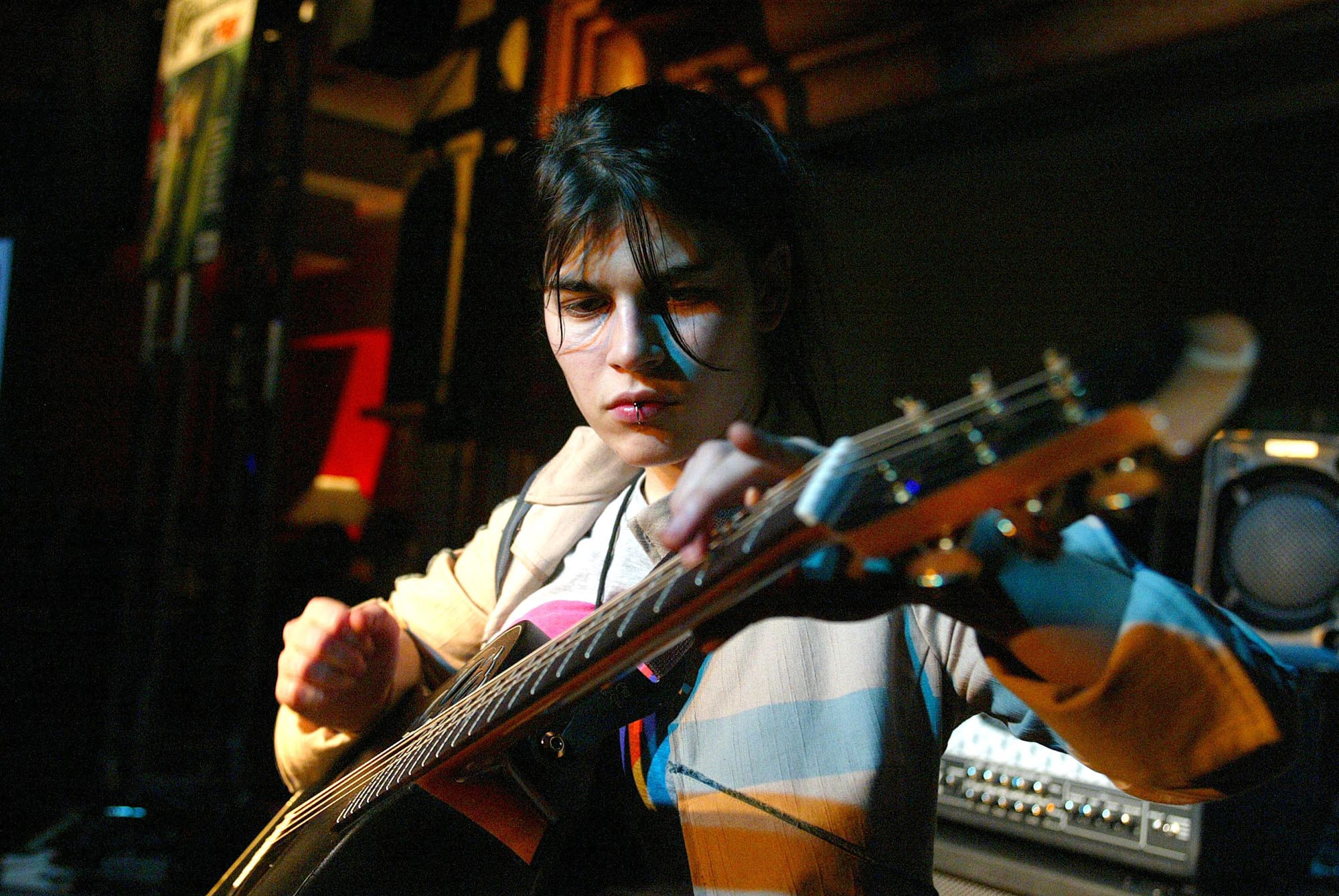 Kaki King pictured in a promotional shot, a tireless sonic adventurer known for her experimental acoustic guitar techniques.
Kaki King pictured in a promotional shot, a tireless sonic adventurer known for her experimental acoustic guitar techniques.
A relentless sonic explorer, Kaki King approaches the acoustic guitar with a unique blend of Preston Reed-inspired percussive techniques and John Cage-like experimentalism. She frequently utilizes alternate tunings, “treated” instruments, and electronic loops, while employing fingerstyle, two-handed tapping, and percussive slapping techniques. “I’ll think, ‘Let’s see what happens if I lower this string here and raise that one there,’” she explained in a 2011 interview. “When you tune your guitar differently, all of a sudden your fingers and your mind have to be creative again because you’re not relying on shapes and places that sound good or feel familiar. You have to explore the fretboard to find new fingerings and sounds, and that leads to new discoveries.” King’s innovative and experimental approach has pushed the boundaries of acoustic guitar playing, making her a highly respected and influential contemporary guitarist.
Key Tracks: “Playing With Pink Noise,” “Skimming the Fractured Surface to a Place of Endless Light”
Gary Clark Jr.
 Gary Clark Jr. pictured in 2012, a Grammy-winning blues-rock guitarist known for blending blues with soul, funk, grunge, and hip-hop.
Gary Clark Jr. pictured in 2012, a Grammy-winning blues-rock guitarist known for blending blues with soul, funk, grunge, and hip-hop.
Initially categorized as an heir to the legacies of Jimi Hendrix and Stevie Ray Vaughan, Grammy-winning blues-rock guitarist Gary Clark Jr. has consistently demonstrated a far broader musical scope in his fiery playing. He seamlessly incorporates elements of soul, funk, grunge, and hip-hop into his recordings, and collaborates with a diverse range of artists from Foo Fighters to Alicia Keys, Tech N9ne, and Bun B. “I don’t think that I’m reaching my full potential if I just do what people expect of me,” he told Rolling Stone in 2014. “I love to play, and I love to experiment, and there are a lot more roads to explore. I don’t know if I want to get too far off the path — I don’t want to get lost in the forest — but I like to wander out a bit and adventure.” Clark Jr.’s adventurous spirit and genre-bending approach have established him as a leading figure in contemporary blues and rock guitar.
Key Tracks: “This Land,” “Grinder”
Amadou Bagayoko
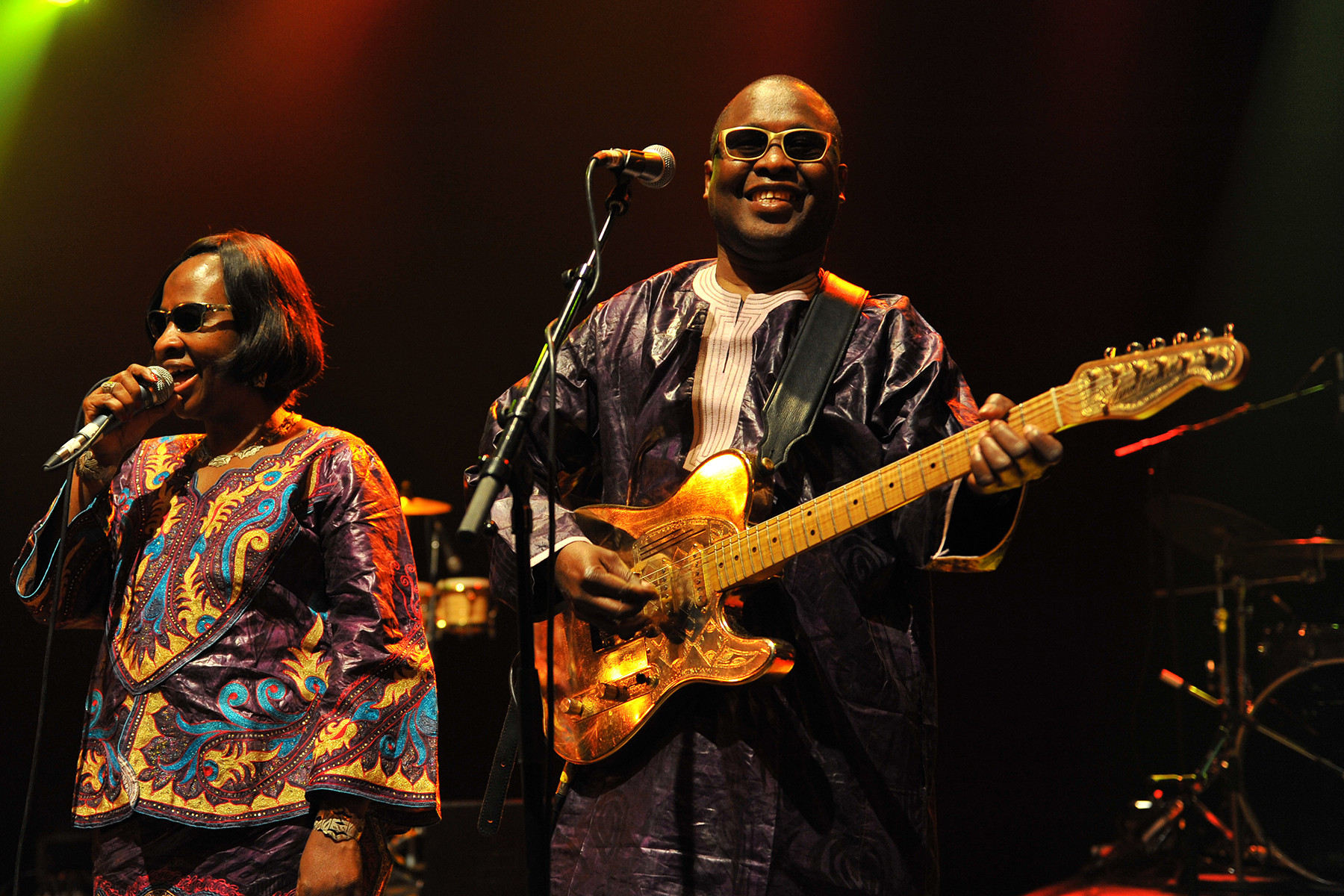 Amadou Bagayoko of Amadou & Mariam performing live in 2012, a Malian guitarist known for his jaunty and occasionally skronky leads in their crossover duets.
Amadou Bagayoko of Amadou & Mariam performing live in 2012, a Malian guitarist known for his jaunty and occasionally skronky leads in their crossover duets.
Malian musicians Amadou Bagayoko and Mariam Doumbia, who met at an institute for the blind in 1977, achieved international recognition as Amadou & Mariam. Their brightly melodic duets, rhythmically driven by Amadou’s jaunty and occasionally skronky guitar leads, resonated beyond traditional African music circles and crossed over into the rock festival circuit. “People are often surprised when we explain how much we were influenced by Western pop music,” Amadou Bagayoko once shared. “I grew up listening to records by Rod Stewart, Led Zeppelin, James Brown, Crosby, Stills, and Nash, Eric Clapton, Jeff Beck, Pink Floyd, Stevie Wonder … That’s because they were the only records we had in Mali!” This eclectic mix of influences is evident in Amadou’s vibrant and engaging guitar style, which is central to Amadou & Mariam’s global appeal.
Key Tracks: “Djanfa,” “Ce N’est Pas Bon”
Justin Broadrick
 Justin Broadrick of Godflesh pictured in a promotional shot, known for his industrial-metal guitar lexicon and steamrolling riffs.
Justin Broadrick of Godflesh pictured in a promotional shot, known for his industrial-metal guitar lexicon and steamrolling riffs.
Justin Broadrick has forged his own unique guitar language across a range of influential projects, including industrial-metal pioneers Godflesh, grindcore originators Napalm Death, and psychedelic post-metal band Jesu, among numerous others. His steamrolling, elastic riffs and dense, spongy textures in Godflesh brought a rare sense of humanity to the band’s otherwise mechanical rhythms. In Napalm Death, he helped pioneer the “grinding” sound of grindcore—hyper-fast death metal—by pushing his distortion to such extreme levels that the listener felt the raw pulse more than individual notes, as exemplified in songs like “Instinct of Survival.” In Jesu, his psychedelic post-metal project, he layered vast miasmas of noise, creating beautiful yet shadowy soundscapes that enveloped his vocals. Across all his projects, Broadrick’s guitar playing sighs, groans, and weeps, creating a sonic signature that is instantly recognizable and utterly unique.
Key Tracks: “Like Rats,” “Silver,” “Scum”
Hugh McCracken
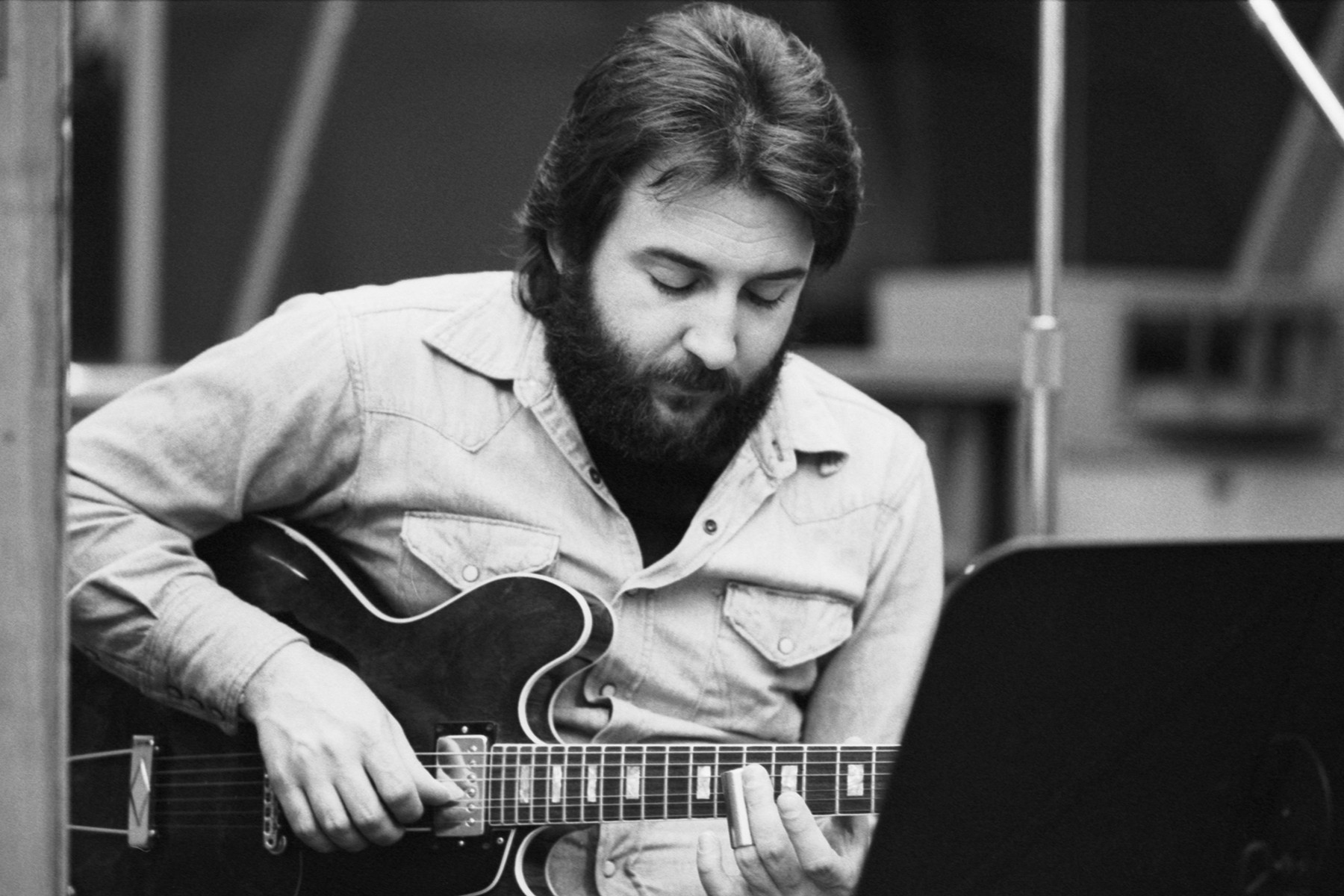 Hugh McCracken pictured during a recording session in 1973, a legendary session guitarist known for his tasteful and piercing leads on countless classics.
Hugh McCracken pictured during a recording session in 1973, a legendary session guitarist known for his tasteful and piercing leads on countless classics.
East Coast guitarist Hugh McCracken was never a flamboyant soloist, but he left his indelible and tasteful mark on an astonishing number of classic recordings. That’s his piercing lead guitar on Steely Dan’s “Hey Nineteen,” his energetic opening lick on Van Morrison’s “Brown Eyed Girl,” and his silky acoustic guitar work throughout Roberta Flack’s “Killing Me Softly With His Song.” In an unobtrusive yet vital way, he also enriched Paul Simon’s “50 Ways to Leave Your Lover,” Alicia Keys’ “If I Ain’t Got You,” and John Lennon and Yoko Ono’s “I’m Losing You.” McCracken was in such high demand and so content with studio work that he famously declined Paul McCartney’s offer to join Wings after playing on the Ram album. His legacy is built on his remarkable versatility and his ability to elevate any song with his perfectly placed and exquisitely tasteful guitar parts.
Key Tracks: “Hey Nineteen,” “Killing Me Softly With His Song”
Eric Johnson
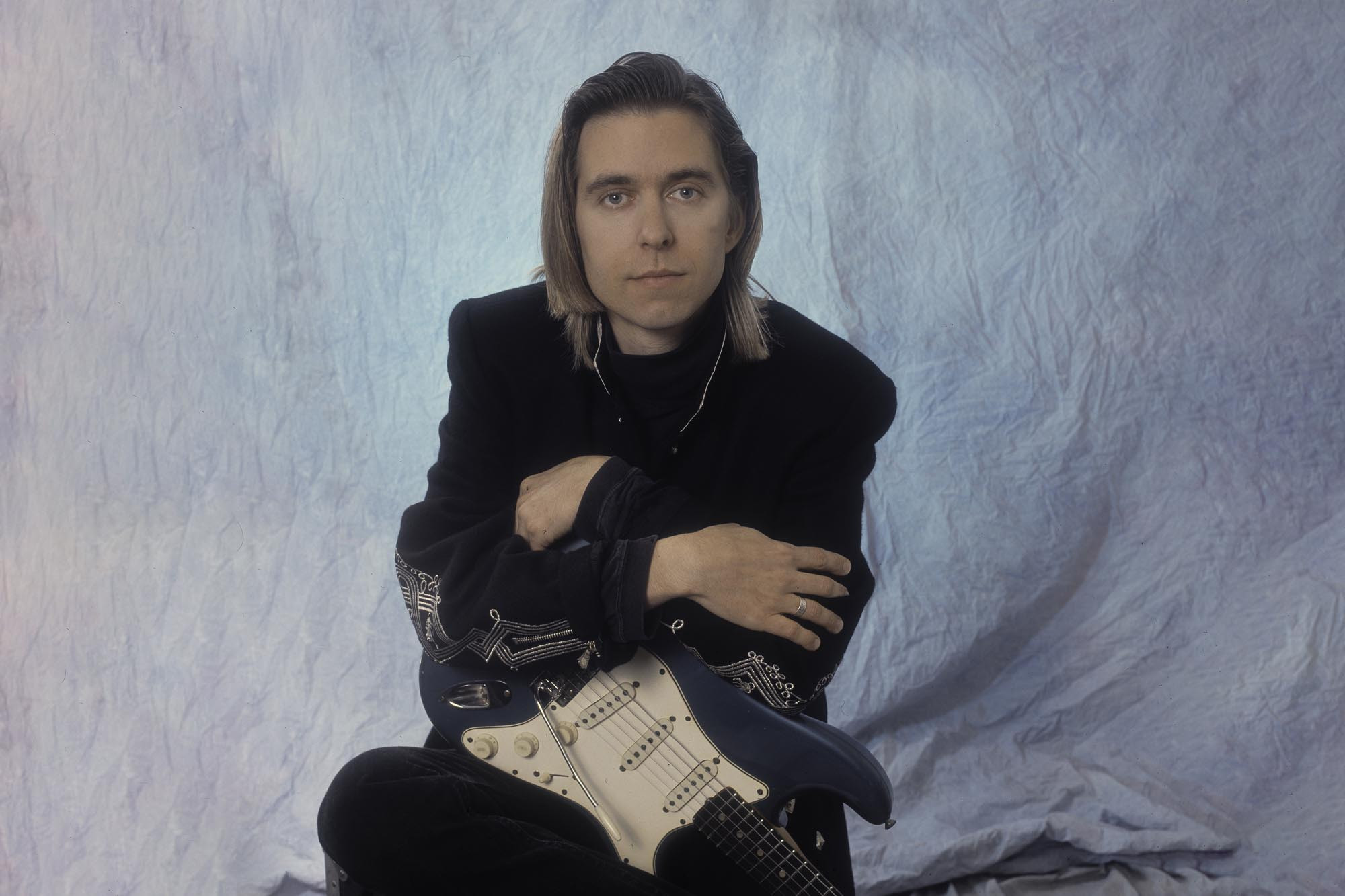 Eric Johnson pictured in 1991, a consummate technician appreciated by his peers for his fusion style and guitar-centric collaborations.
Eric Johnson pictured in 1991, a consummate technician appreciated by his peers for his fusion style and guitar-centric collaborations.
A consummate guitar technician, Austin-born Eric Johnson is the kind of player whose exceptional abilities are often more deeply appreciated by fellow musicians than by the general public. “Eric’s so good it’s ridiculous,” raved Steve Morse, while Stevie Ray Vaughan hailed him as “one of my favorite guitarists.” Billy Gibbons succinctly assessed, “Damn, that guy can play!” A fusion stylist whose approach leans more towards rock than jazz, Johnson was a rising star in the mid-1970s Austin music scene but experienced career setbacks due to contractual disputes. Although his 1990 instrumental album Ah Via Musicom eventually achieved platinum status, he is perhaps best known for his guitar-centric collaborations, such as the G3 tours with Joe Satriani and Steve Vai, and Eclectic, his project with Miles Davis guitarist Mike Stern. Johnson’s phenomenal technique and melodic sophistication have earned him a dedicated following among guitar enthusiasts and musicians alike.
Key Tracks: “Cliffs of Dover,” “Benny Man’s Blues”
Lynn Taitt
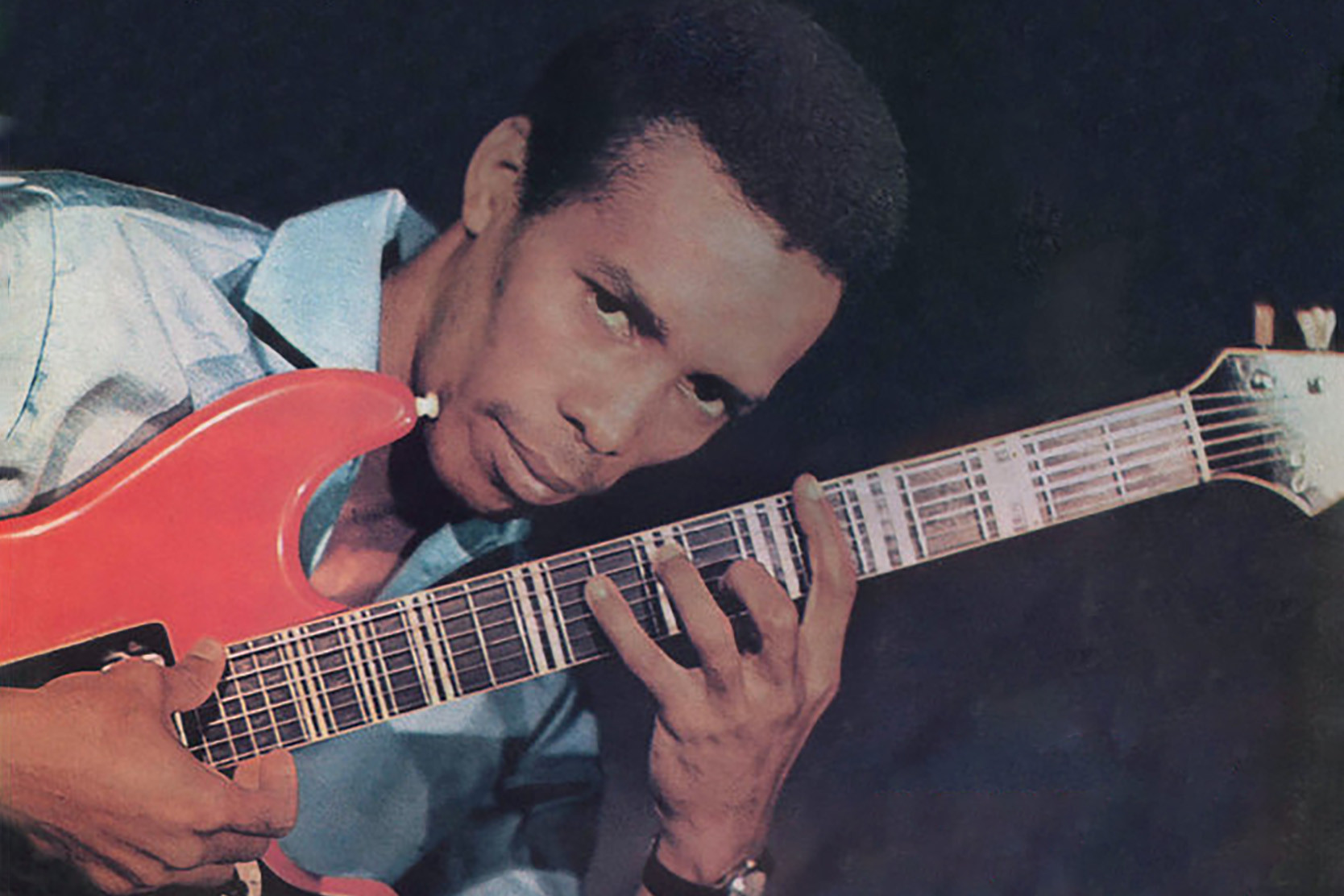 Lynn Taitt pictured in a promotional shot, a Jamaican guitarist who essentially created the guitar sound of rocksteady music.
Lynn Taitt pictured in a promotional shot, a Jamaican guitarist who essentially created the guitar sound of rocksteady music.
Lynn Taitt, born in Trinidad but making his name in Jamaica, essentially defined the guitar sound of rocksteady music through his playing on early recordings in the genre, such as Hopeton Lewis’ “Take It Easy” and Derrick Morgan’s “Tougher Than Tough.” When Jamaican guitar legend Ernest Ranglin relocated to England in 1964, Taitt became the premier session guitarist on the island. His guitar work on Desmond Dekker’s iconic “007 (Shanty Town)” is among the most recognizable guitar parts in Jamaican music history. Although his active period in the Jamaican music scene was relatively brief—he moved to Canada in 1968—his influence and importance were cemented when his student Hux Brown refined Taitt’s playing style, helping to shape the sound of reggae guitar. Lynn Taitt’s pioneering work laid the foundation for the distinctive guitar styles that would define Jamaican popular music for decades to come.
Key Tracks: “007 (Shanty Town),” “Take It Easy”
Grant Green
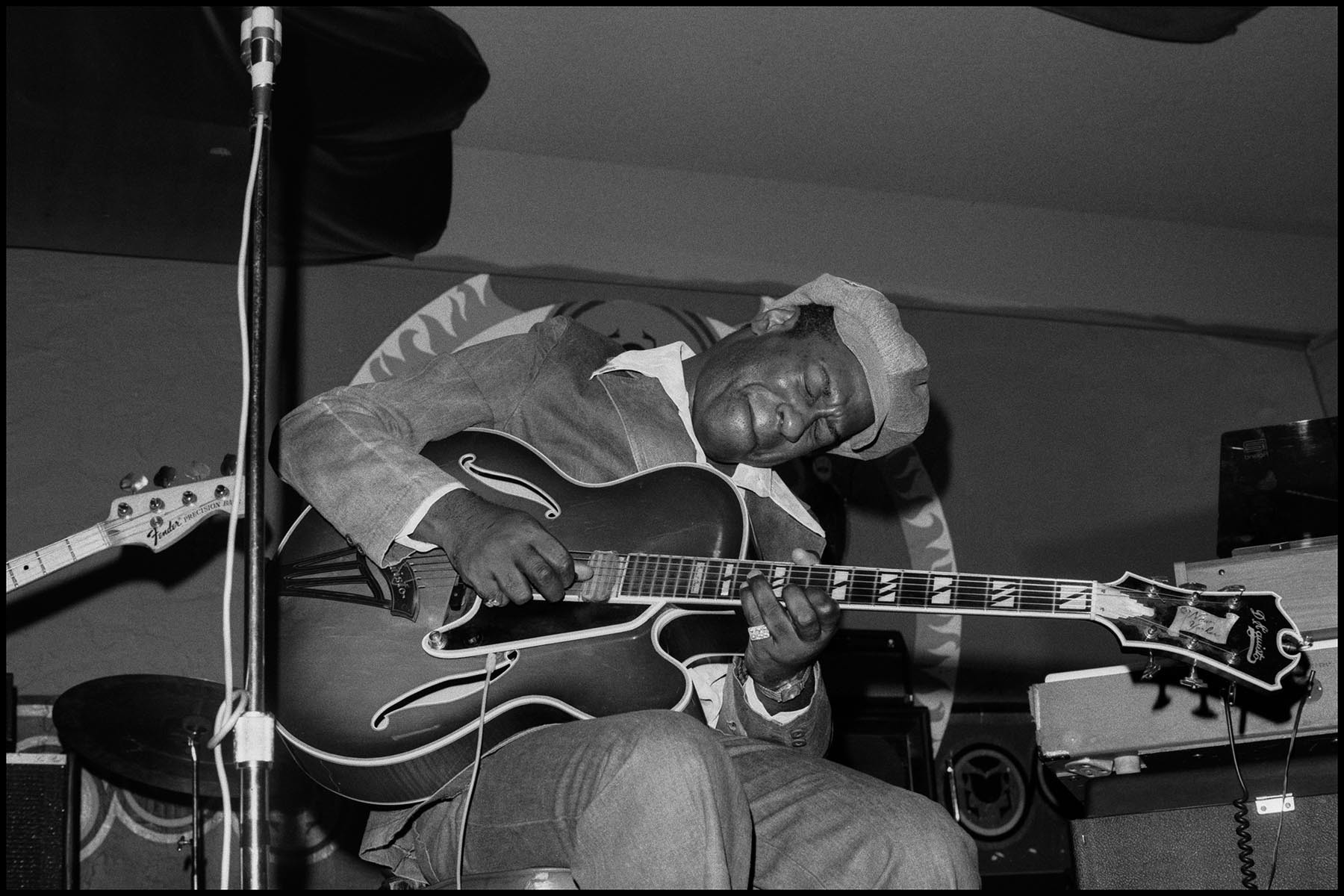 Grant Green performing live in 1975, a soul-jazz pioneer known for his impeccably cool grooves and influence on hip-hop sampling.
Grant Green performing live in 1975, a soul-jazz pioneer known for his impeccably cool grooves and influence on hip-hop sampling.
Grant Green emerged from the hard bop jazz scene to become a pivotal figure in soul-jazz. A devoted Charlie Parker fan from St. Louis, he recorded his Blue Note debut in 1960 and embarked on a stellar five-year run with impeccably cool grooves exemplified by albums like Idle Moments and The Complete Quartets With Sonny Clark. He explored Latin jazz on his 1964 album Matador, featuring Elvin Jones and McCoy Tyner. Green tragically passed away in 1979 at just 43 years old while in New York City for a gig at George Benson’s Breezin’ Lounge. However, his musical influence continues to thrive, particularly in hip-hop. His guitar playing has been sampled extensively on rap classics, from A Tribe Called Quest’s The Low End Theory to Kendrick Lamar’s Good Kid, m.A.A.d City. Grant Green’s sophisticated and groove-oriented guitar style has left an enduring legacy across jazz and hip-hop genres.
Key Tracks: “Idle Moments,” “Jean De Fleur,” “On Green Dolphin Street”
Vince Gill
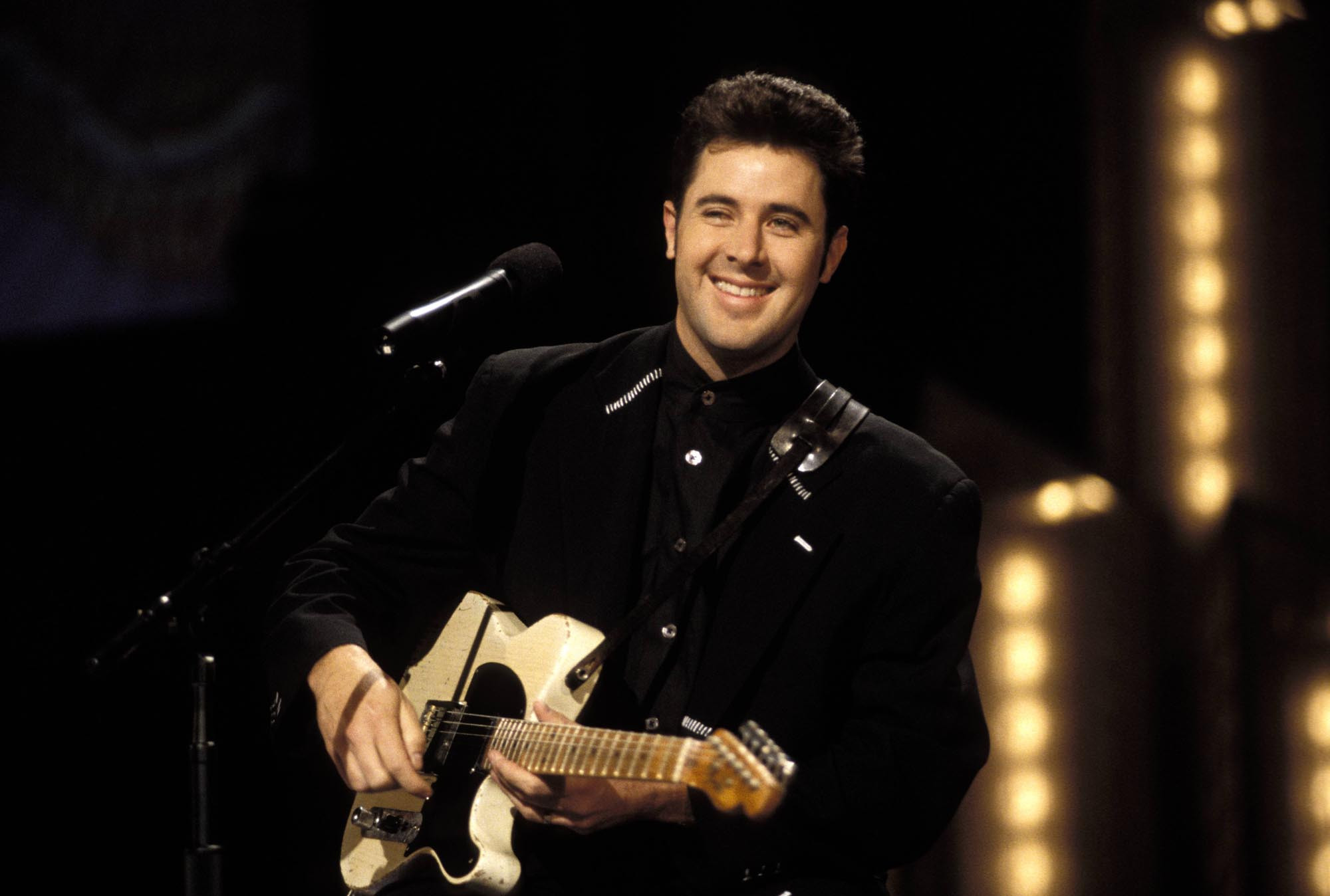 Vince Gill performing live, a country music great known for his vocals and lethal Fender guitar playing, blending chicken picking and twangy bends.
Vince Gill performing live, a country music great known for his vocals and lethal Fender guitar playing, blending chicken picking and twangy bends.
It’s almost an unfair level of talent—Vince Gill is rightfully celebrated as one of country music’s greatest vocalists of all time. Yet, beyond his vocal prowess, he is also exceptionally skilled with an electric Fender guitar in his hands. In addition to his lively chicken picking and twangy bends on singles like 1991’s “Liza Jane,” Gill has paid homage to California country guitar legends like Don Rich and Roy Nichols on his 2013 album Bakersfield. Moreover, Gill’s guitar skills are in constant demand for sessions on countless other artists’ albums, including Miranda Lambert, Emmylou Harris, Patty Loveless, Kenny Chesney, Dolly Parton, and Don Henley. Speaking of Henley, Gill has been a touring member of the Eagles since Glenn Frey’s passing in 2017, seamlessly pulling double duty as a harmony vocalist and guitar slinger extraordinaire. Vince Gill’s dual talents as a vocalist and guitarist solidify his place as a true icon in country music.
Key Tracks: “Liza Jane,” “Oklahoma Borderline”
Garry ‘Diaper Man’ Shider
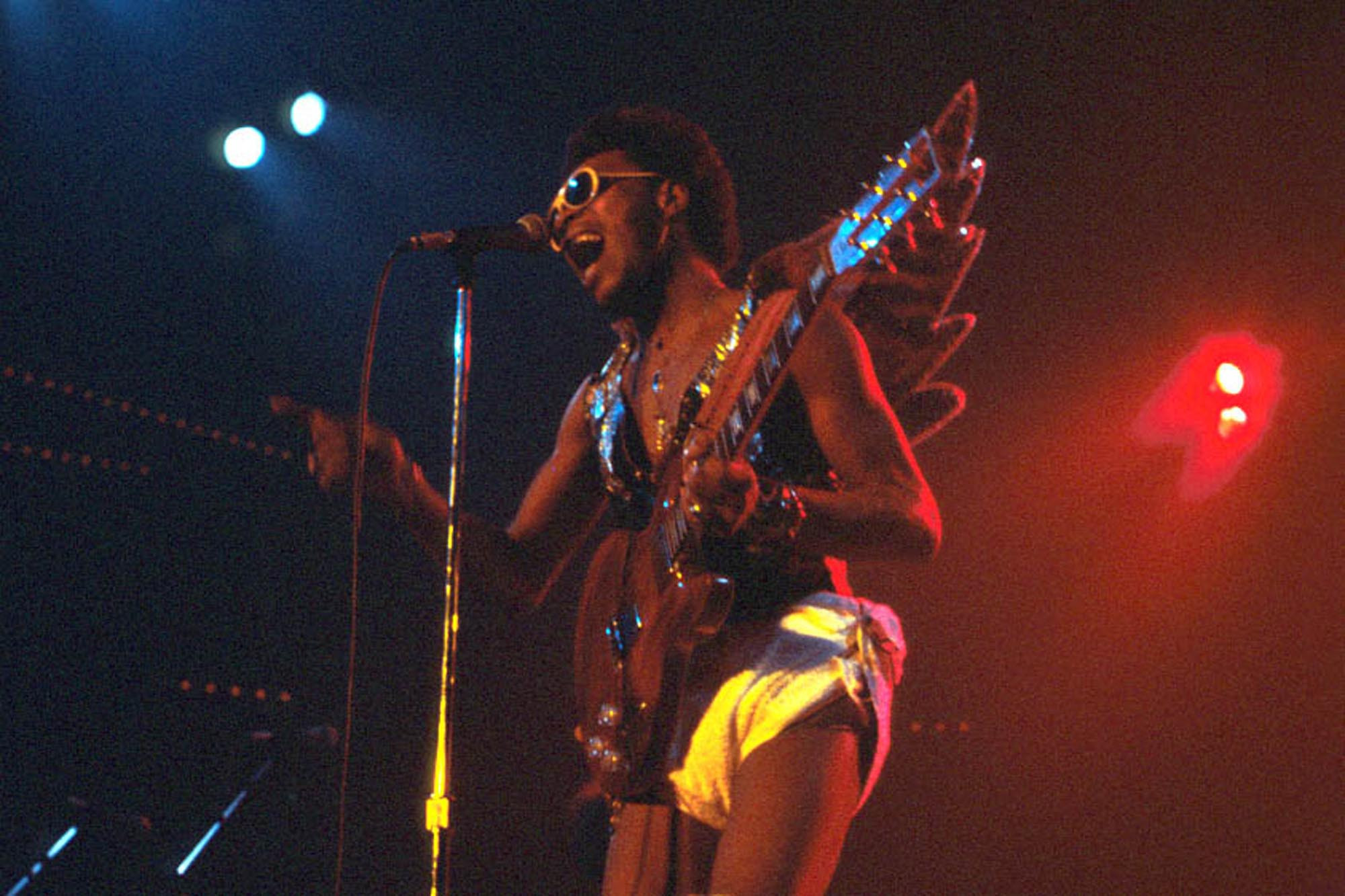 Garry "Diaper Man" Shider of Parliament performing in 1977, a funk guitarist known for his searing leads and funky rhythm work in Parliament/Funkadelic.
Garry "Diaper Man" Shider of Parliament performing in 1977, a funk guitarist known for his searing leads and funky rhythm work in Parliament/Funkadelic.
When asked about his onstage persona of performing in little more than an oversized diaper, Parliament/Funkadelic guitarist Garry Shider famously quipped, “God loves babies and fools. I’m both.” While initially celebrated for bringing the “-delic” to Funkadelic through his searing, distortion-laden lead guitar work on jams like “Cosmic Slop,” Shider was also a master rhythm guitarist. This is evident in his insistently funky playing on iconic tracks like “One Nation Under a Groove” and “Atomic Dog,” both of which he co-wrote. Beyond his “Diaper Man” persona in Parliament/Funkadelic, he was also known as “Starchild” in Bootsy’s Rubberband and served as music director for the P-Funk All Stars. His post-P-Funk career included diverse collaborations with Paul Schaffer and the Black Crowes. Garry Shider’s multifaceted talents and unique stage presence made him a vital and unforgettable part of the Parliament-Funkadelic universe.
Key Tracks: “Cosmic Slop,” “One Nation Under a Groove”
Conclusion
This expanded exploration into the realm of greatest rock guitar players reveals a rich tapestry of talent, innovation, and enduring influence. From the foundational figures who shaped the very sound of rock and roll to the contemporary innovators pushing the instrument’s boundaries, these guitarists represent a diverse spectrum of styles, techniques, and musical visions. They are not just instrumentalists; they are storytellers, sonic architects, and cultural icons whose contributions have resonated across genres and generations.
The criteria for greatness in rock guitar, as highlighted throughout these profiles, extend far beyond technical proficiency. It encompasses originality, emotional depth, songwriting contribution, and the ability to connect with audiences on a profound level. These guitarists, whether celebrated virtuosos or unassuming radicals, share a common thread: they have each harnessed the expressive power of the guitar to create music that is both impactful and timeless.
As the guitar continues to evolve and inspire new generations of musicians, the legacies of these greatest rock guitar players will undoubtedly endure. They serve as a reminder that the guitar is not merely an instrument, but a voice, an extension of the soul, capable of expressing the full spectrum of human experience through music.

